Ethical Analysis: Victoria's Secret Report on Sustainability
VerifiedAdded on 2021/06/17
|21
|4814
|110
Report
AI Summary
This report provides an in-depth ethical analysis of Victoria's Secret, focusing on the environmental impact of their products and operations. It examines the lifecycle of a Victoria's Secret bra, from material extraction (cotton, spandex, polyester) to manufacturing, packaging, transport, use, and end-of-life. The report highlights concerns regarding the use of hazardous chemicals, water consumption, and waste generation. It assesses Victoria's Secret's past environmental practices and current initiatives, such as sourcing organic cotton and commitments to reduce hazardous chemicals. The report also suggests additional steps the company can take to improve sustainability, including eliminating catalogs and establishing a recycling program. The analysis considers the company's efforts in ethical changes that improve their sustainability policies. The report also compares Victoria's Secret's practices with those of competitors, concluding with recommendations for more sustainable practices and a call for greater transparency and eco-friendliness. This report provides a comprehensive overview of the ethical and environmental issues associated with Victoria's Secret and offers insights into potential solutions.
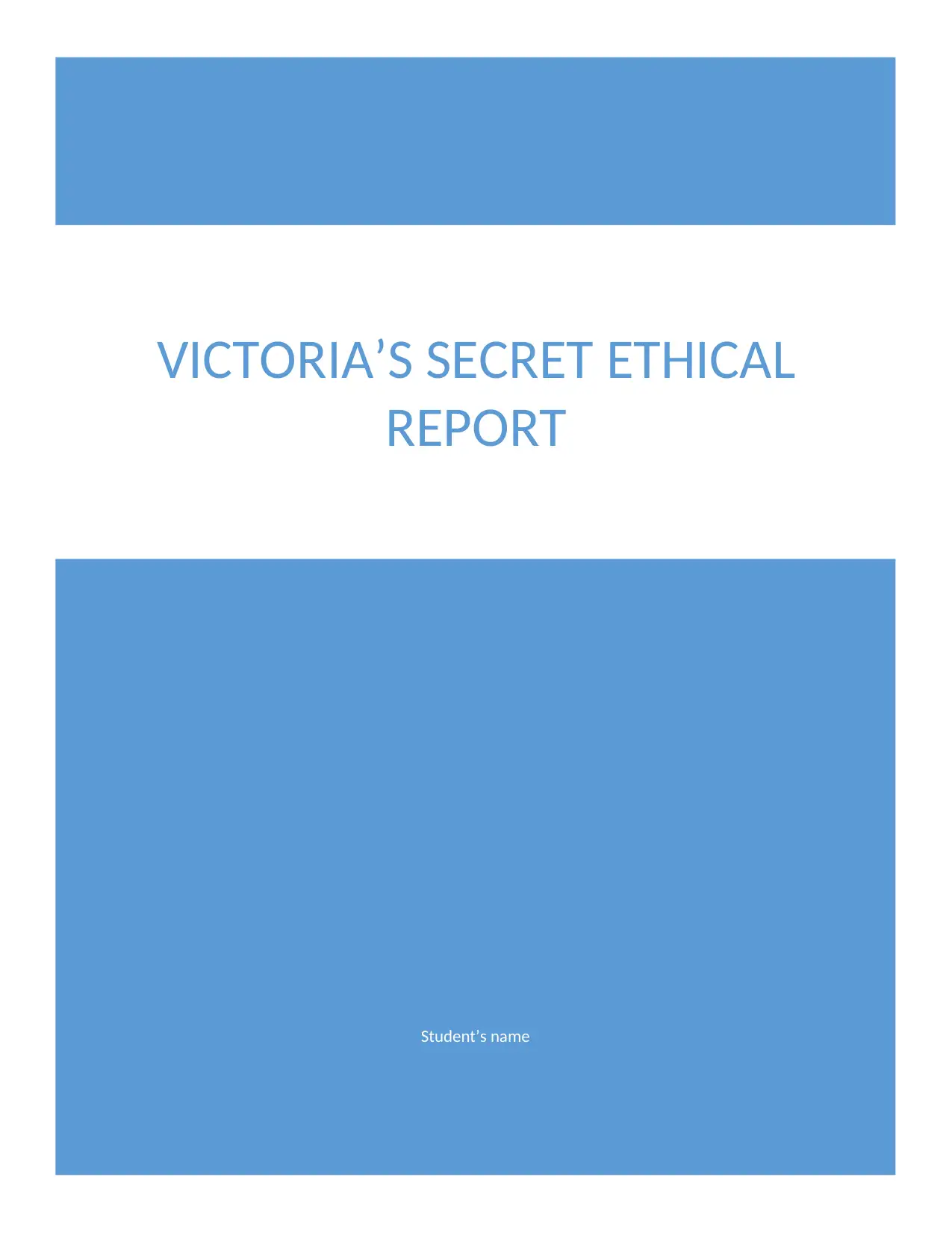
Student’s name
VICTORIA’S SECRET ETHICAL
REPORT
VICTORIA’S SECRET ETHICAL
REPORT
Secure Best Marks with AI Grader
Need help grading? Try our AI Grader for instant feedback on your assignments.
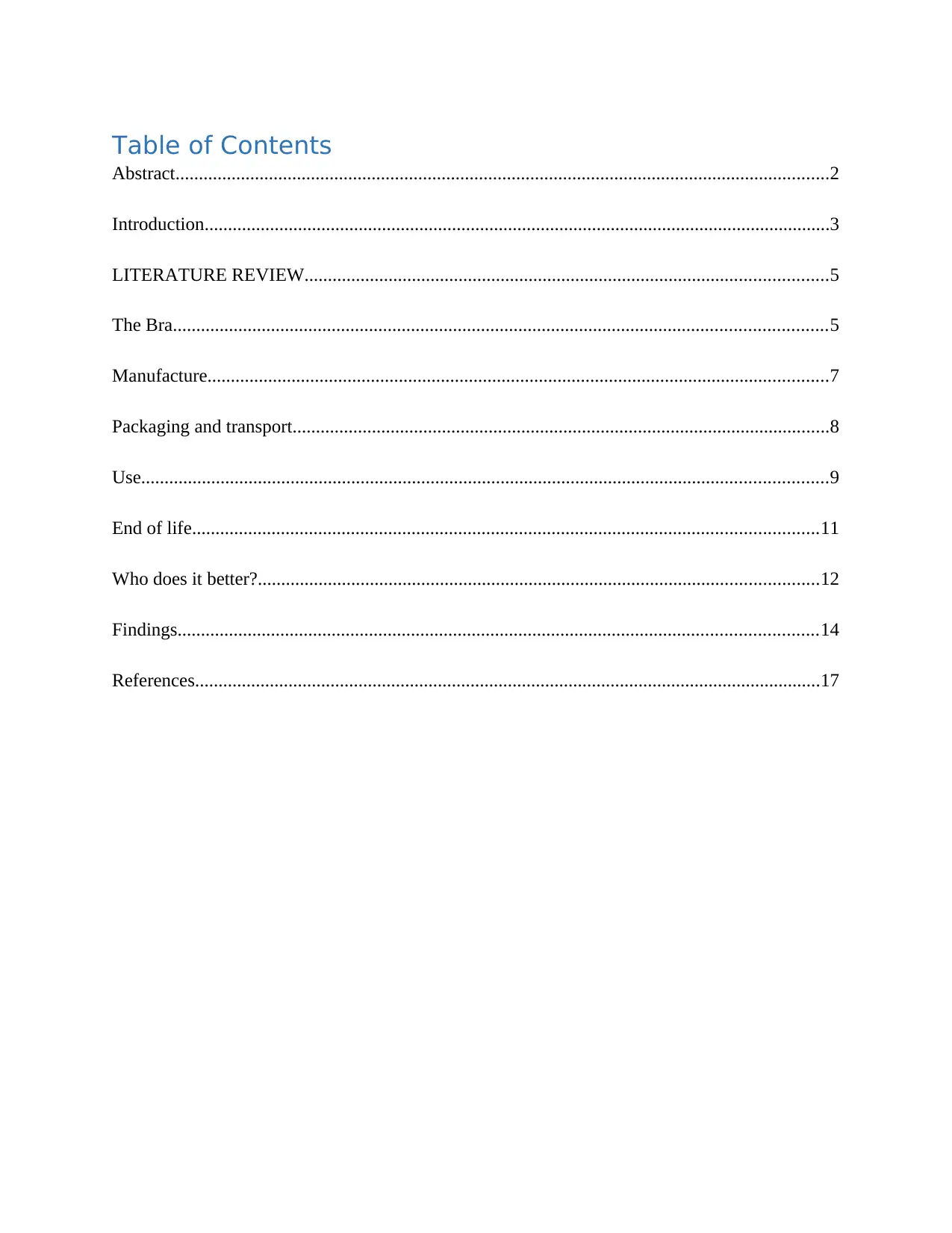
Table of Contents
Abstract............................................................................................................................................2
Introduction......................................................................................................................................3
LITERATURE REVIEW................................................................................................................5
The Bra............................................................................................................................................5
Manufacture.....................................................................................................................................7
Packaging and transport...................................................................................................................8
Use...................................................................................................................................................9
End of life......................................................................................................................................11
Who does it better?........................................................................................................................12
Findings.........................................................................................................................................14
References......................................................................................................................................17
Abstract............................................................................................................................................2
Introduction......................................................................................................................................3
LITERATURE REVIEW................................................................................................................5
The Bra............................................................................................................................................5
Manufacture.....................................................................................................................................7
Packaging and transport...................................................................................................................8
Use...................................................................................................................................................9
End of life......................................................................................................................................11
Who does it better?........................................................................................................................12
Findings.........................................................................................................................................14
References......................................................................................................................................17
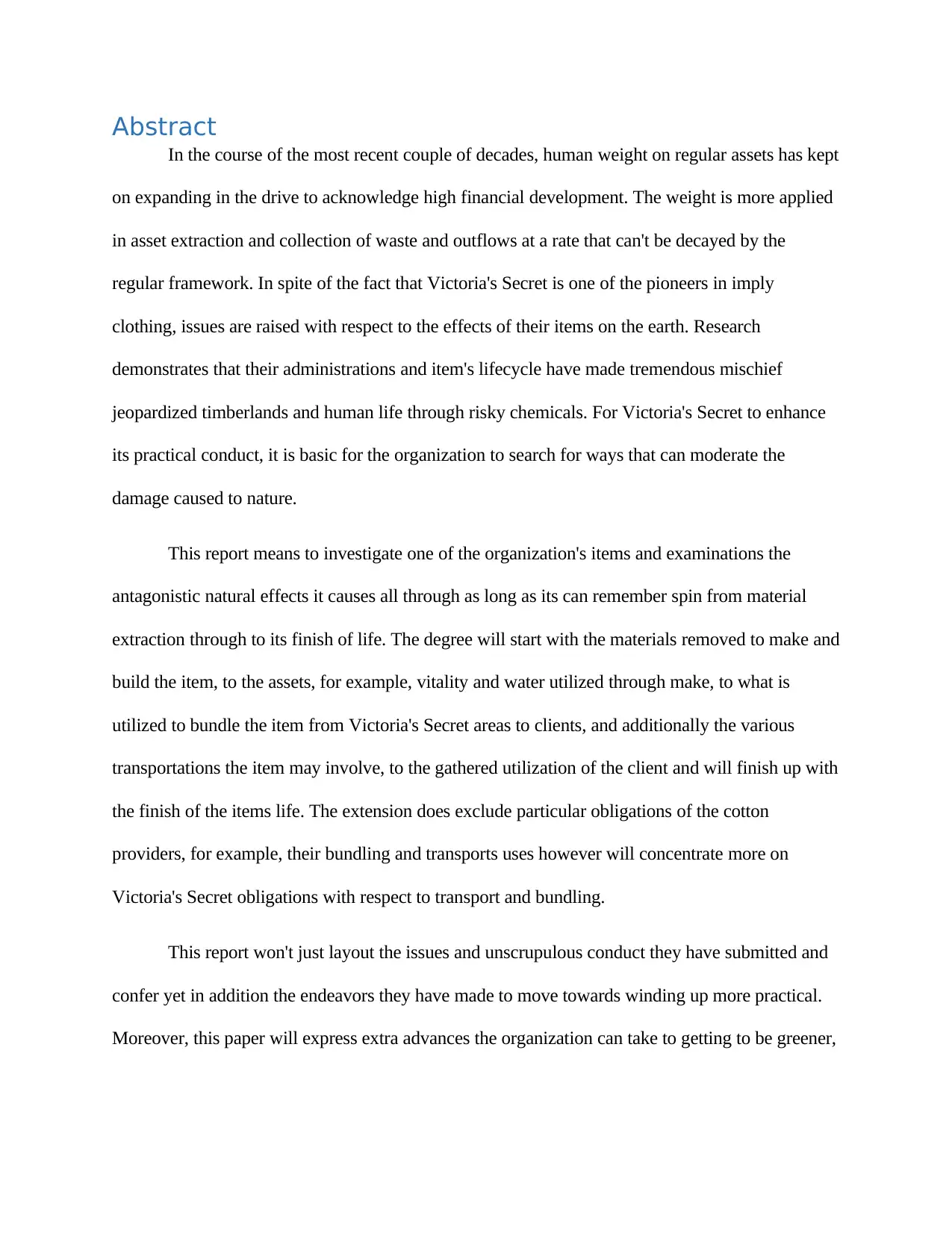
Abstract
In the course of the most recent couple of decades, human weight on regular assets has kept
on expanding in the drive to acknowledge high financial development. The weight is more applied
in asset extraction and collection of waste and outflows at a rate that can't be decayed by the
regular framework. In spite of the fact that Victoria's Secret is one of the pioneers in imply
clothing, issues are raised with respect to the effects of their items on the earth. Research
demonstrates that their administrations and item's lifecycle have made tremendous mischief
jeopardized timberlands and human life through risky chemicals. For Victoria's Secret to enhance
its practical conduct, it is basic for the organization to search for ways that can moderate the
damage caused to nature.
This report means to investigate one of the organization's items and examinations the
antagonistic natural effects it causes all through as long as its can remember spin from material
extraction through to its finish of life. The degree will start with the materials removed to make and
build the item, to the assets, for example, vitality and water utilized through make, to what is
utilized to bundle the item from Victoria's Secret areas to clients, and additionally the various
transportations the item may involve, to the gathered utilization of the client and will finish up with
the finish of the items life. The extension does exclude particular obligations of the cotton
providers, for example, their bundling and transports uses however will concentrate more on
Victoria's Secret obligations with respect to transport and bundling.
This report won't just layout the issues and unscrupulous conduct they have submitted and
confer yet in addition the endeavors they have made to move towards winding up more practical.
Moreover, this paper will express extra advances the organization can take to getting to be greener,
In the course of the most recent couple of decades, human weight on regular assets has kept
on expanding in the drive to acknowledge high financial development. The weight is more applied
in asset extraction and collection of waste and outflows at a rate that can't be decayed by the
regular framework. In spite of the fact that Victoria's Secret is one of the pioneers in imply
clothing, issues are raised with respect to the effects of their items on the earth. Research
demonstrates that their administrations and item's lifecycle have made tremendous mischief
jeopardized timberlands and human life through risky chemicals. For Victoria's Secret to enhance
its practical conduct, it is basic for the organization to search for ways that can moderate the
damage caused to nature.
This report means to investigate one of the organization's items and examinations the
antagonistic natural effects it causes all through as long as its can remember spin from material
extraction through to its finish of life. The degree will start with the materials removed to make and
build the item, to the assets, for example, vitality and water utilized through make, to what is
utilized to bundle the item from Victoria's Secret areas to clients, and additionally the various
transportations the item may involve, to the gathered utilization of the client and will finish up with
the finish of the items life. The extension does exclude particular obligations of the cotton
providers, for example, their bundling and transports uses however will concentrate more on
Victoria's Secret obligations with respect to transport and bundling.
This report won't just layout the issues and unscrupulous conduct they have submitted and
confer yet in addition the endeavors they have made to move towards winding up more practical.
Moreover, this paper will express extra advances the organization can take to getting to be greener,
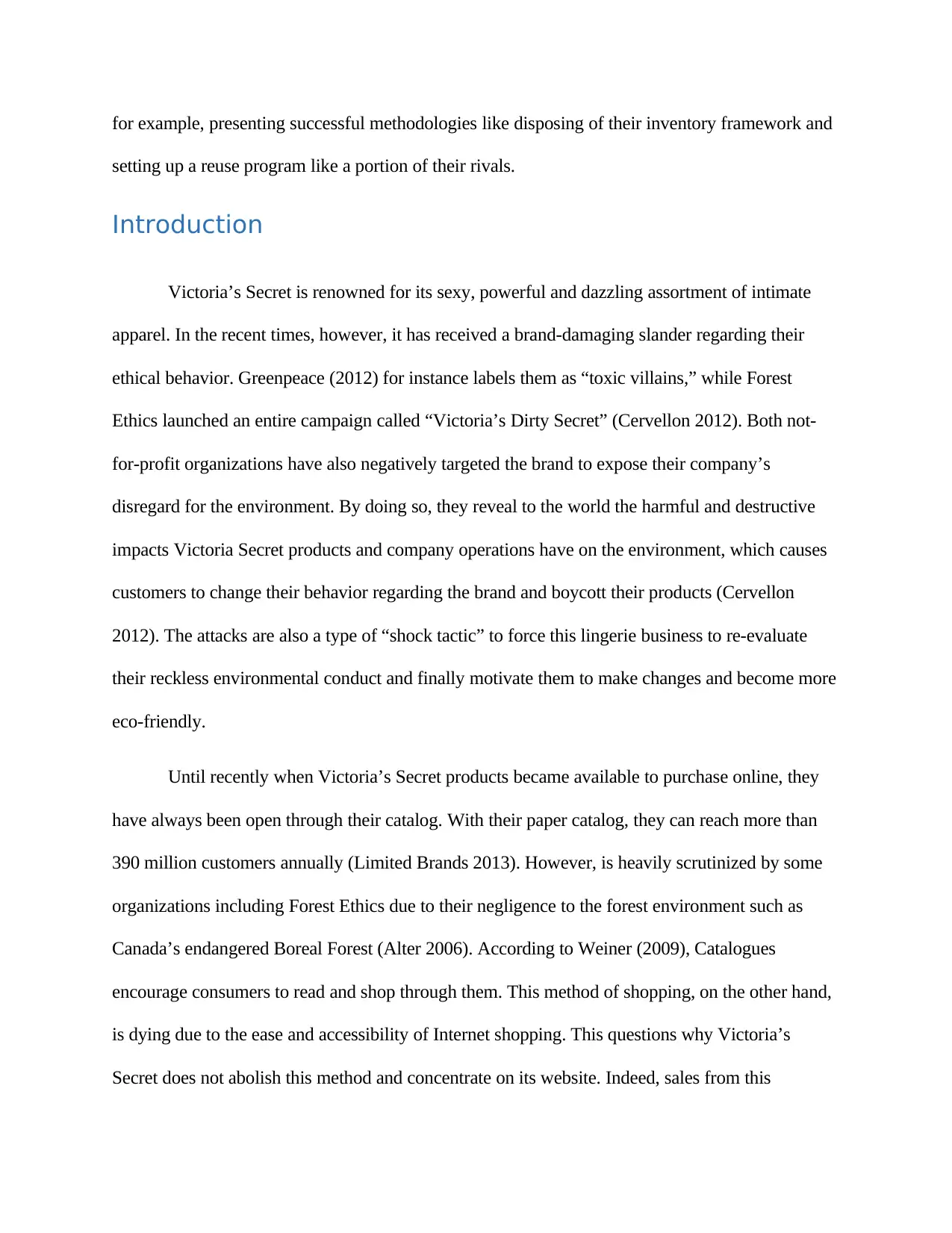
for example, presenting successful methodologies like disposing of their inventory framework and
setting up a reuse program like a portion of their rivals.
Introduction
Victoria’s Secret is renowned for its sexy, powerful and dazzling assortment of intimate
apparel. In the recent times, however, it has received a brand-damaging slander regarding their
ethical behavior. Greenpeace (2012) for instance labels them as “toxic villains,” while Forest
Ethics launched an entire campaign called “Victoria’s Dirty Secret” (Cervellon 2012). Both not-
for-profit organizations have also negatively targeted the brand to expose their company’s
disregard for the environment. By doing so, they reveal to the world the harmful and destructive
impacts Victoria Secret products and company operations have on the environment, which causes
customers to change their behavior regarding the brand and boycott their products (Cervellon
2012). The attacks are also a type of “shock tactic” to force this lingerie business to re-evaluate
their reckless environmental conduct and finally motivate them to make changes and become more
eco-friendly.
Until recently when Victoria’s Secret products became available to purchase online, they
have always been open through their catalog. With their paper catalog, they can reach more than
390 million customers annually (Limited Brands 2013). However, is heavily scrutinized by some
organizations including Forest Ethics due to their negligence to the forest environment such as
Canada’s endangered Boreal Forest (Alter 2006). According to Weiner (2009), Catalogues
encourage consumers to read and shop through them. This method of shopping, on the other hand,
is dying due to the ease and accessibility of Internet shopping. This questions why Victoria’s
Secret does not abolish this method and concentrate on its website. Indeed, sales from this
setting up a reuse program like a portion of their rivals.
Introduction
Victoria’s Secret is renowned for its sexy, powerful and dazzling assortment of intimate
apparel. In the recent times, however, it has received a brand-damaging slander regarding their
ethical behavior. Greenpeace (2012) for instance labels them as “toxic villains,” while Forest
Ethics launched an entire campaign called “Victoria’s Dirty Secret” (Cervellon 2012). Both not-
for-profit organizations have also negatively targeted the brand to expose their company’s
disregard for the environment. By doing so, they reveal to the world the harmful and destructive
impacts Victoria Secret products and company operations have on the environment, which causes
customers to change their behavior regarding the brand and boycott their products (Cervellon
2012). The attacks are also a type of “shock tactic” to force this lingerie business to re-evaluate
their reckless environmental conduct and finally motivate them to make changes and become more
eco-friendly.
Until recently when Victoria’s Secret products became available to purchase online, they
have always been open through their catalog. With their paper catalog, they can reach more than
390 million customers annually (Limited Brands 2013). However, is heavily scrutinized by some
organizations including Forest Ethics due to their negligence to the forest environment such as
Canada’s endangered Boreal Forest (Alter 2006). According to Weiner (2009), Catalogues
encourage consumers to read and shop through them. This method of shopping, on the other hand,
is dying due to the ease and accessibility of Internet shopping. This questions why Victoria’s
Secret does not abolish this method and concentrate on its website. Indeed, sales from this
Secure Best Marks with AI Grader
Need help grading? Try our AI Grader for instant feedback on your assignments.
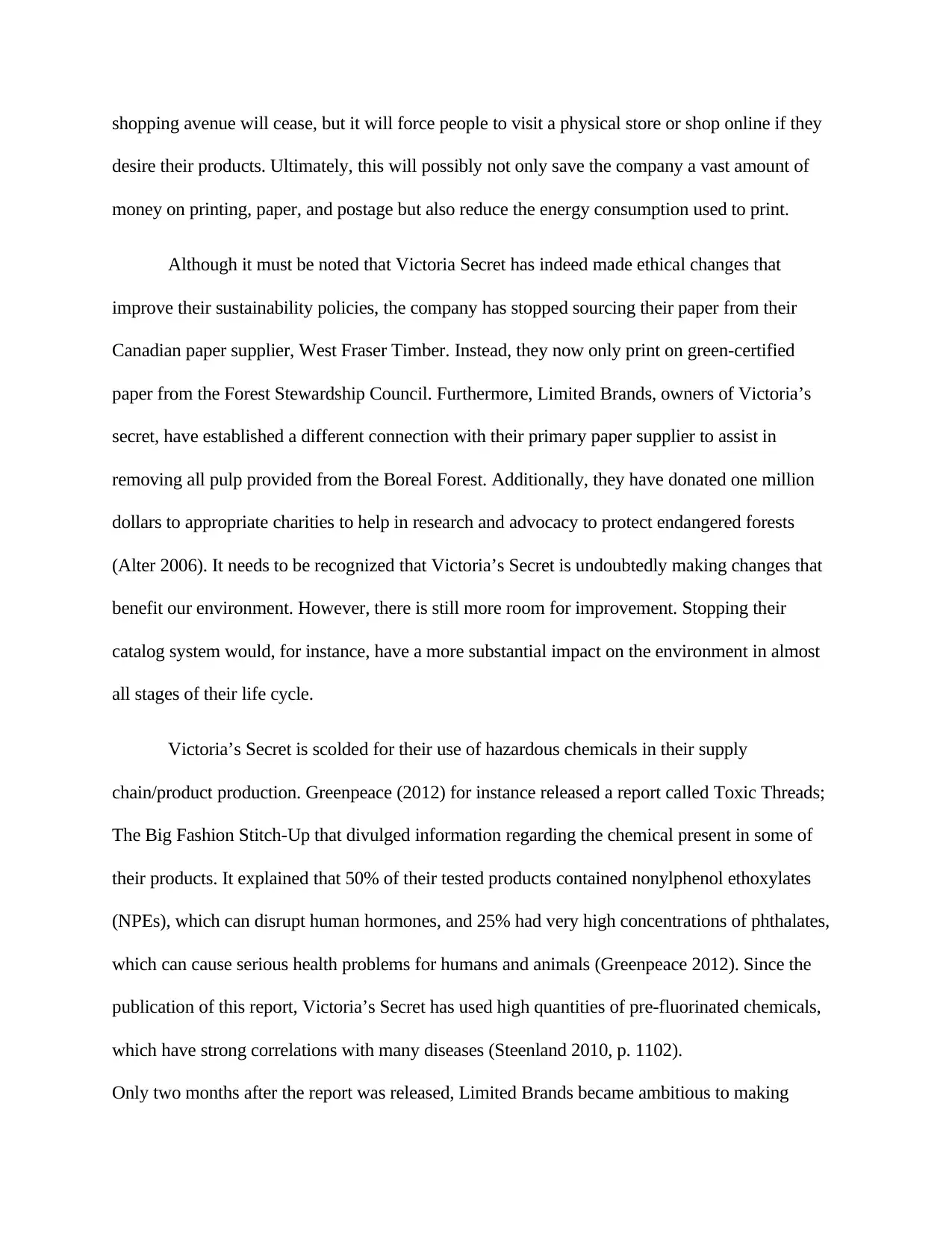
shopping avenue will cease, but it will force people to visit a physical store or shop online if they
desire their products. Ultimately, this will possibly not only save the company a vast amount of
money on printing, paper, and postage but also reduce the energy consumption used to print.
Although it must be noted that Victoria Secret has indeed made ethical changes that
improve their sustainability policies, the company has stopped sourcing their paper from their
Canadian paper supplier, West Fraser Timber. Instead, they now only print on green-certified
paper from the Forest Stewardship Council. Furthermore, Limited Brands, owners of Victoria’s
secret, have established a different connection with their primary paper supplier to assist in
removing all pulp provided from the Boreal Forest. Additionally, they have donated one million
dollars to appropriate charities to help in research and advocacy to protect endangered forests
(Alter 2006). It needs to be recognized that Victoria’s Secret is undoubtedly making changes that
benefit our environment. However, there is still more room for improvement. Stopping their
catalog system would, for instance, have a more substantial impact on the environment in almost
all stages of their life cycle.
Victoria’s Secret is scolded for their use of hazardous chemicals in their supply
chain/product production. Greenpeace (2012) for instance released a report called Toxic Threads;
The Big Fashion Stitch-Up that divulged information regarding the chemical present in some of
their products. It explained that 50% of their tested products contained nonylphenol ethoxylates
(NPEs), which can disrupt human hormones, and 25% had very high concentrations of phthalates,
which can cause serious health problems for humans and animals (Greenpeace 2012). Since the
publication of this report, Victoria’s Secret has used high quantities of pre-fluorinated chemicals,
which have strong correlations with many diseases (Steenland 2010, p. 1102).
Only two months after the report was released, Limited Brands became ambitious to making
desire their products. Ultimately, this will possibly not only save the company a vast amount of
money on printing, paper, and postage but also reduce the energy consumption used to print.
Although it must be noted that Victoria Secret has indeed made ethical changes that
improve their sustainability policies, the company has stopped sourcing their paper from their
Canadian paper supplier, West Fraser Timber. Instead, they now only print on green-certified
paper from the Forest Stewardship Council. Furthermore, Limited Brands, owners of Victoria’s
secret, have established a different connection with their primary paper supplier to assist in
removing all pulp provided from the Boreal Forest. Additionally, they have donated one million
dollars to appropriate charities to help in research and advocacy to protect endangered forests
(Alter 2006). It needs to be recognized that Victoria’s Secret is undoubtedly making changes that
benefit our environment. However, there is still more room for improvement. Stopping their
catalog system would, for instance, have a more substantial impact on the environment in almost
all stages of their life cycle.
Victoria’s Secret is scolded for their use of hazardous chemicals in their supply
chain/product production. Greenpeace (2012) for instance released a report called Toxic Threads;
The Big Fashion Stitch-Up that divulged information regarding the chemical present in some of
their products. It explained that 50% of their tested products contained nonylphenol ethoxylates
(NPEs), which can disrupt human hormones, and 25% had very high concentrations of phthalates,
which can cause serious health problems for humans and animals (Greenpeace 2012). Since the
publication of this report, Victoria’s Secret has used high quantities of pre-fluorinated chemicals,
which have strong correlations with many diseases (Steenland 2010, p. 1102).
Only two months after the report was released, Limited Brands became ambitious to making
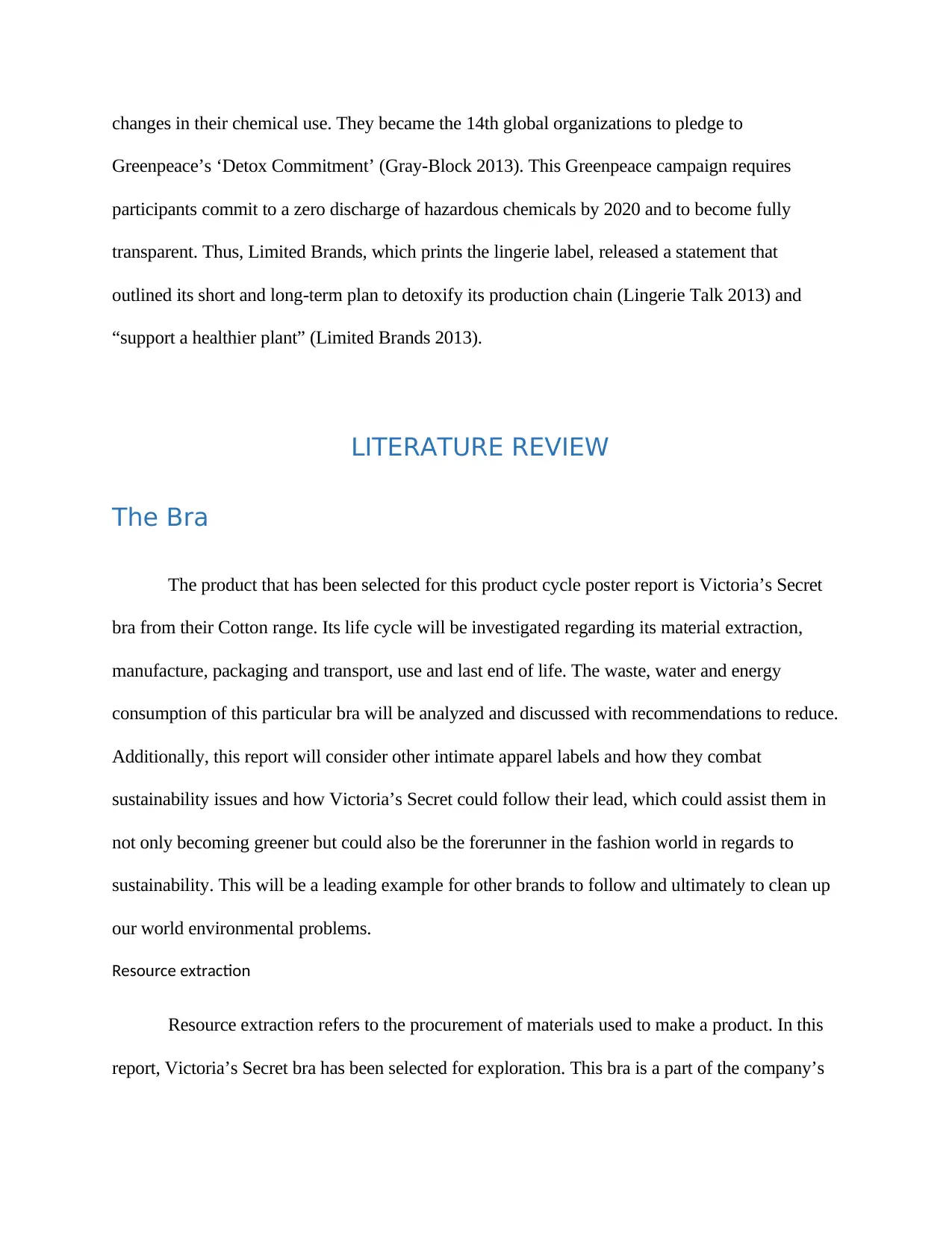
changes in their chemical use. They became the 14th global organizations to pledge to
Greenpeace’s ‘Detox Commitment’ (Gray-Block 2013). This Greenpeace campaign requires
participants commit to a zero discharge of hazardous chemicals by 2020 and to become fully
transparent. Thus, Limited Brands, which prints the lingerie label, released a statement that
outlined its short and long-term plan to detoxify its production chain (Lingerie Talk 2013) and
“support a healthier plant” (Limited Brands 2013).
LITERATURE REVIEW
The Bra
The product that has been selected for this product cycle poster report is Victoria’s Secret
bra from their Cotton range. Its life cycle will be investigated regarding its material extraction,
manufacture, packaging and transport, use and last end of life. The waste, water and energy
consumption of this particular bra will be analyzed and discussed with recommendations to reduce.
Additionally, this report will consider other intimate apparel labels and how they combat
sustainability issues and how Victoria’s Secret could follow their lead, which could assist them in
not only becoming greener but could also be the forerunner in the fashion world in regards to
sustainability. This will be a leading example for other brands to follow and ultimately to clean up
our world environmental problems.
Resource extraction
Resource extraction refers to the procurement of materials used to make a product. In this
report, Victoria’s Secret bra has been selected for exploration. This bra is a part of the company’s
Greenpeace’s ‘Detox Commitment’ (Gray-Block 2013). This Greenpeace campaign requires
participants commit to a zero discharge of hazardous chemicals by 2020 and to become fully
transparent. Thus, Limited Brands, which prints the lingerie label, released a statement that
outlined its short and long-term plan to detoxify its production chain (Lingerie Talk 2013) and
“support a healthier plant” (Limited Brands 2013).
LITERATURE REVIEW
The Bra
The product that has been selected for this product cycle poster report is Victoria’s Secret
bra from their Cotton range. Its life cycle will be investigated regarding its material extraction,
manufacture, packaging and transport, use and last end of life. The waste, water and energy
consumption of this particular bra will be analyzed and discussed with recommendations to reduce.
Additionally, this report will consider other intimate apparel labels and how they combat
sustainability issues and how Victoria’s Secret could follow their lead, which could assist them in
not only becoming greener but could also be the forerunner in the fashion world in regards to
sustainability. This will be a leading example for other brands to follow and ultimately to clean up
our world environmental problems.
Resource extraction
Resource extraction refers to the procurement of materials used to make a product. In this
report, Victoria’s Secret bra has been selected for exploration. This bra is a part of the company’s
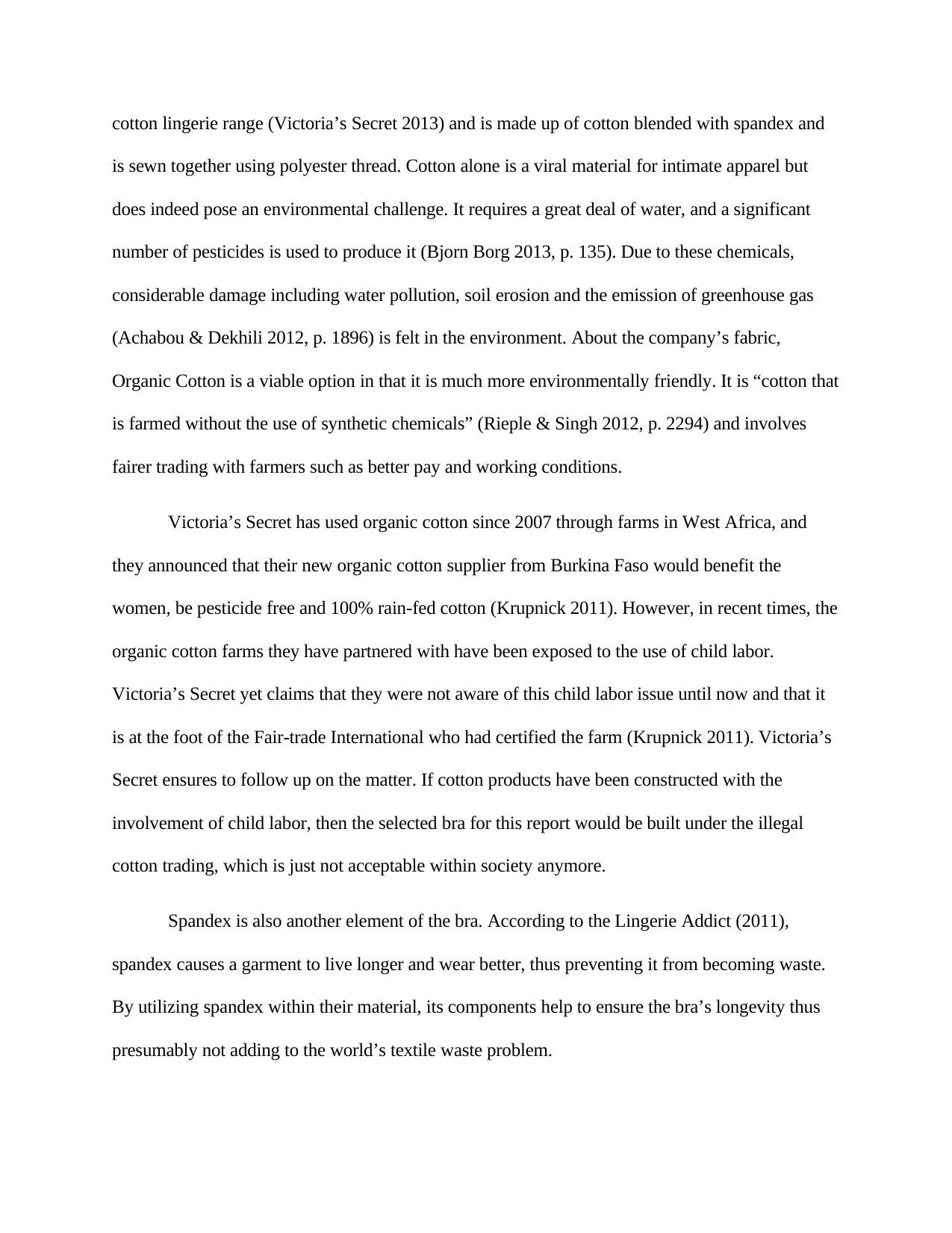
cotton lingerie range (Victoria’s Secret 2013) and is made up of cotton blended with spandex and
is sewn together using polyester thread. Cotton alone is a viral material for intimate apparel but
does indeed pose an environmental challenge. It requires a great deal of water, and a significant
number of pesticides is used to produce it (Bjorn Borg 2013, p. 135). Due to these chemicals,
considerable damage including water pollution, soil erosion and the emission of greenhouse gas
(Achabou & Dekhili 2012, p. 1896) is felt in the environment. About the company’s fabric,
Organic Cotton is a viable option in that it is much more environmentally friendly. It is “cotton that
is farmed without the use of synthetic chemicals” (Rieple & Singh 2012, p. 2294) and involves
fairer trading with farmers such as better pay and working conditions.
Victoria’s Secret has used organic cotton since 2007 through farms in West Africa, and
they announced that their new organic cotton supplier from Burkina Faso would benefit the
women, be pesticide free and 100% rain-fed cotton (Krupnick 2011). However, in recent times, the
organic cotton farms they have partnered with have been exposed to the use of child labor.
Victoria’s Secret yet claims that they were not aware of this child labor issue until now and that it
is at the foot of the Fair-trade International who had certified the farm (Krupnick 2011). Victoria’s
Secret ensures to follow up on the matter. If cotton products have been constructed with the
involvement of child labor, then the selected bra for this report would be built under the illegal
cotton trading, which is just not acceptable within society anymore.
Spandex is also another element of the bra. According to the Lingerie Addict (2011),
spandex causes a garment to live longer and wear better, thus preventing it from becoming waste.
By utilizing spandex within their material, its components help to ensure the bra’s longevity thus
presumably not adding to the world’s textile waste problem.
is sewn together using polyester thread. Cotton alone is a viral material for intimate apparel but
does indeed pose an environmental challenge. It requires a great deal of water, and a significant
number of pesticides is used to produce it (Bjorn Borg 2013, p. 135). Due to these chemicals,
considerable damage including water pollution, soil erosion and the emission of greenhouse gas
(Achabou & Dekhili 2012, p. 1896) is felt in the environment. About the company’s fabric,
Organic Cotton is a viable option in that it is much more environmentally friendly. It is “cotton that
is farmed without the use of synthetic chemicals” (Rieple & Singh 2012, p. 2294) and involves
fairer trading with farmers such as better pay and working conditions.
Victoria’s Secret has used organic cotton since 2007 through farms in West Africa, and
they announced that their new organic cotton supplier from Burkina Faso would benefit the
women, be pesticide free and 100% rain-fed cotton (Krupnick 2011). However, in recent times, the
organic cotton farms they have partnered with have been exposed to the use of child labor.
Victoria’s Secret yet claims that they were not aware of this child labor issue until now and that it
is at the foot of the Fair-trade International who had certified the farm (Krupnick 2011). Victoria’s
Secret ensures to follow up on the matter. If cotton products have been constructed with the
involvement of child labor, then the selected bra for this report would be built under the illegal
cotton trading, which is just not acceptable within society anymore.
Spandex is also another element of the bra. According to the Lingerie Addict (2011),
spandex causes a garment to live longer and wear better, thus preventing it from becoming waste.
By utilizing spandex within their material, its components help to ensure the bra’s longevity thus
presumably not adding to the world’s textile waste problem.
Paraphrase This Document
Need a fresh take? Get an instant paraphrase of this document with our AI Paraphraser
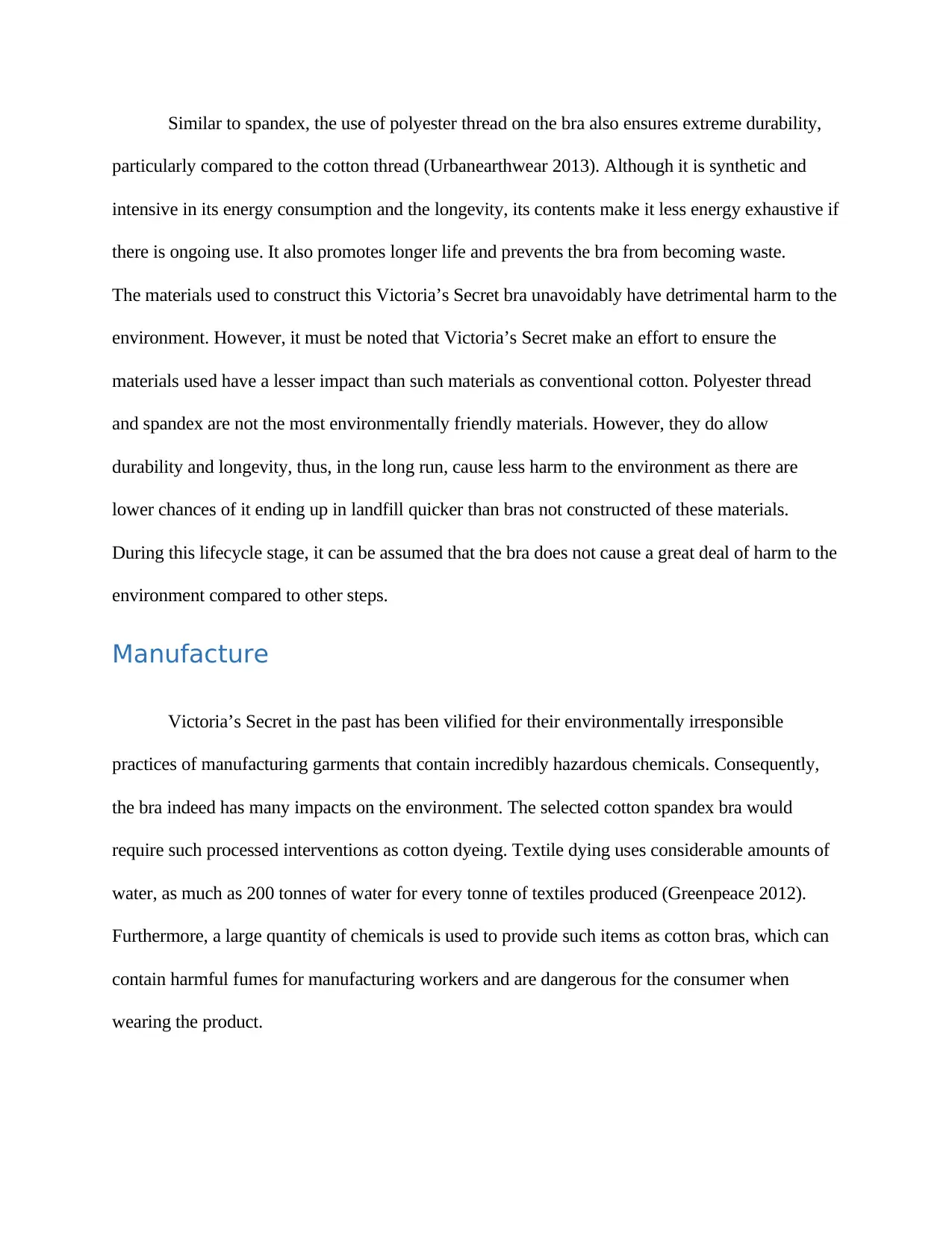
Similar to spandex, the use of polyester thread on the bra also ensures extreme durability,
particularly compared to the cotton thread (Urbanearthwear 2013). Although it is synthetic and
intensive in its energy consumption and the longevity, its contents make it less energy exhaustive if
there is ongoing use. It also promotes longer life and prevents the bra from becoming waste.
The materials used to construct this Victoria’s Secret bra unavoidably have detrimental harm to the
environment. However, it must be noted that Victoria’s Secret make an effort to ensure the
materials used have a lesser impact than such materials as conventional cotton. Polyester thread
and spandex are not the most environmentally friendly materials. However, they do allow
durability and longevity, thus, in the long run, cause less harm to the environment as there are
lower chances of it ending up in landfill quicker than bras not constructed of these materials.
During this lifecycle stage, it can be assumed that the bra does not cause a great deal of harm to the
environment compared to other steps.
Manufacture
Victoria’s Secret in the past has been vilified for their environmentally irresponsible
practices of manufacturing garments that contain incredibly hazardous chemicals. Consequently,
the bra indeed has many impacts on the environment. The selected cotton spandex bra would
require such processed interventions as cotton dyeing. Textile dying uses considerable amounts of
water, as much as 200 tonnes of water for every tonne of textiles produced (Greenpeace 2012).
Furthermore, a large quantity of chemicals is used to provide such items as cotton bras, which can
contain harmful fumes for manufacturing workers and are dangerous for the consumer when
wearing the product.
particularly compared to the cotton thread (Urbanearthwear 2013). Although it is synthetic and
intensive in its energy consumption and the longevity, its contents make it less energy exhaustive if
there is ongoing use. It also promotes longer life and prevents the bra from becoming waste.
The materials used to construct this Victoria’s Secret bra unavoidably have detrimental harm to the
environment. However, it must be noted that Victoria’s Secret make an effort to ensure the
materials used have a lesser impact than such materials as conventional cotton. Polyester thread
and spandex are not the most environmentally friendly materials. However, they do allow
durability and longevity, thus, in the long run, cause less harm to the environment as there are
lower chances of it ending up in landfill quicker than bras not constructed of these materials.
During this lifecycle stage, it can be assumed that the bra does not cause a great deal of harm to the
environment compared to other steps.
Manufacture
Victoria’s Secret in the past has been vilified for their environmentally irresponsible
practices of manufacturing garments that contain incredibly hazardous chemicals. Consequently,
the bra indeed has many impacts on the environment. The selected cotton spandex bra would
require such processed interventions as cotton dyeing. Textile dying uses considerable amounts of
water, as much as 200 tonnes of water for every tonne of textiles produced (Greenpeace 2012).
Furthermore, a large quantity of chemicals is used to provide such items as cotton bras, which can
contain harmful fumes for manufacturing workers and are dangerous for the consumer when
wearing the product.
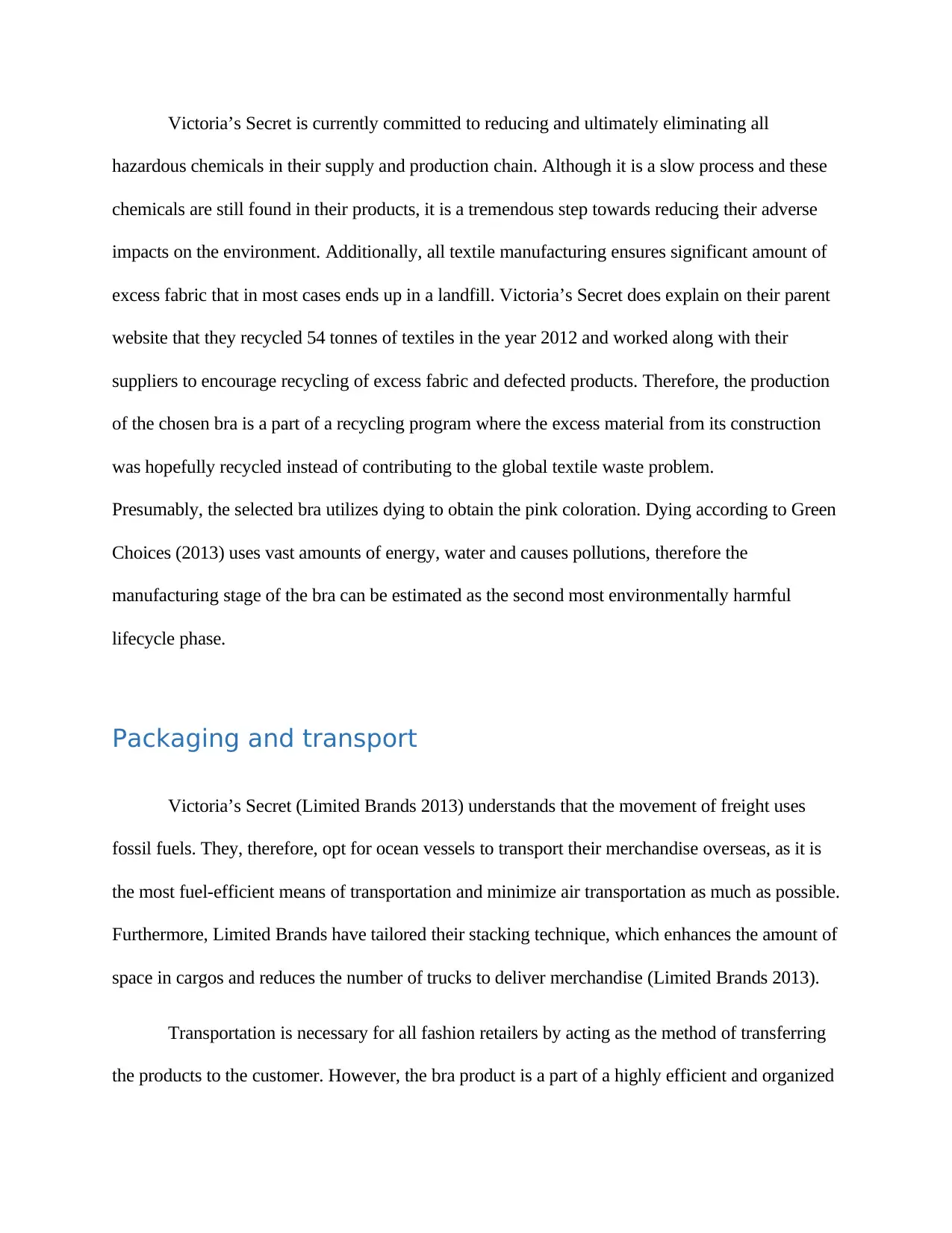
Victoria’s Secret is currently committed to reducing and ultimately eliminating all
hazardous chemicals in their supply and production chain. Although it is a slow process and these
chemicals are still found in their products, it is a tremendous step towards reducing their adverse
impacts on the environment. Additionally, all textile manufacturing ensures significant amount of
excess fabric that in most cases ends up in a landfill. Victoria’s Secret does explain on their parent
website that they recycled 54 tonnes of textiles in the year 2012 and worked along with their
suppliers to encourage recycling of excess fabric and defected products. Therefore, the production
of the chosen bra is a part of a recycling program where the excess material from its construction
was hopefully recycled instead of contributing to the global textile waste problem.
Presumably, the selected bra utilizes dying to obtain the pink coloration. Dying according to Green
Choices (2013) uses vast amounts of energy, water and causes pollutions, therefore the
manufacturing stage of the bra can be estimated as the second most environmentally harmful
lifecycle phase.
Packaging and transport
Victoria’s Secret (Limited Brands 2013) understands that the movement of freight uses
fossil fuels. They, therefore, opt for ocean vessels to transport their merchandise overseas, as it is
the most fuel-efficient means of transportation and minimize air transportation as much as possible.
Furthermore, Limited Brands have tailored their stacking technique, which enhances the amount of
space in cargos and reduces the number of trucks to deliver merchandise (Limited Brands 2013).
Transportation is necessary for all fashion retailers by acting as the method of transferring
the products to the customer. However, the bra product is a part of a highly efficient and organized
hazardous chemicals in their supply and production chain. Although it is a slow process and these
chemicals are still found in their products, it is a tremendous step towards reducing their adverse
impacts on the environment. Additionally, all textile manufacturing ensures significant amount of
excess fabric that in most cases ends up in a landfill. Victoria’s Secret does explain on their parent
website that they recycled 54 tonnes of textiles in the year 2012 and worked along with their
suppliers to encourage recycling of excess fabric and defected products. Therefore, the production
of the chosen bra is a part of a recycling program where the excess material from its construction
was hopefully recycled instead of contributing to the global textile waste problem.
Presumably, the selected bra utilizes dying to obtain the pink coloration. Dying according to Green
Choices (2013) uses vast amounts of energy, water and causes pollutions, therefore the
manufacturing stage of the bra can be estimated as the second most environmentally harmful
lifecycle phase.
Packaging and transport
Victoria’s Secret (Limited Brands 2013) understands that the movement of freight uses
fossil fuels. They, therefore, opt for ocean vessels to transport their merchandise overseas, as it is
the most fuel-efficient means of transportation and minimize air transportation as much as possible.
Furthermore, Limited Brands have tailored their stacking technique, which enhances the amount of
space in cargos and reduces the number of trucks to deliver merchandise (Limited Brands 2013).
Transportation is necessary for all fashion retailers by acting as the method of transferring
the products to the customer. However, the bra product is a part of a highly efficient and organized
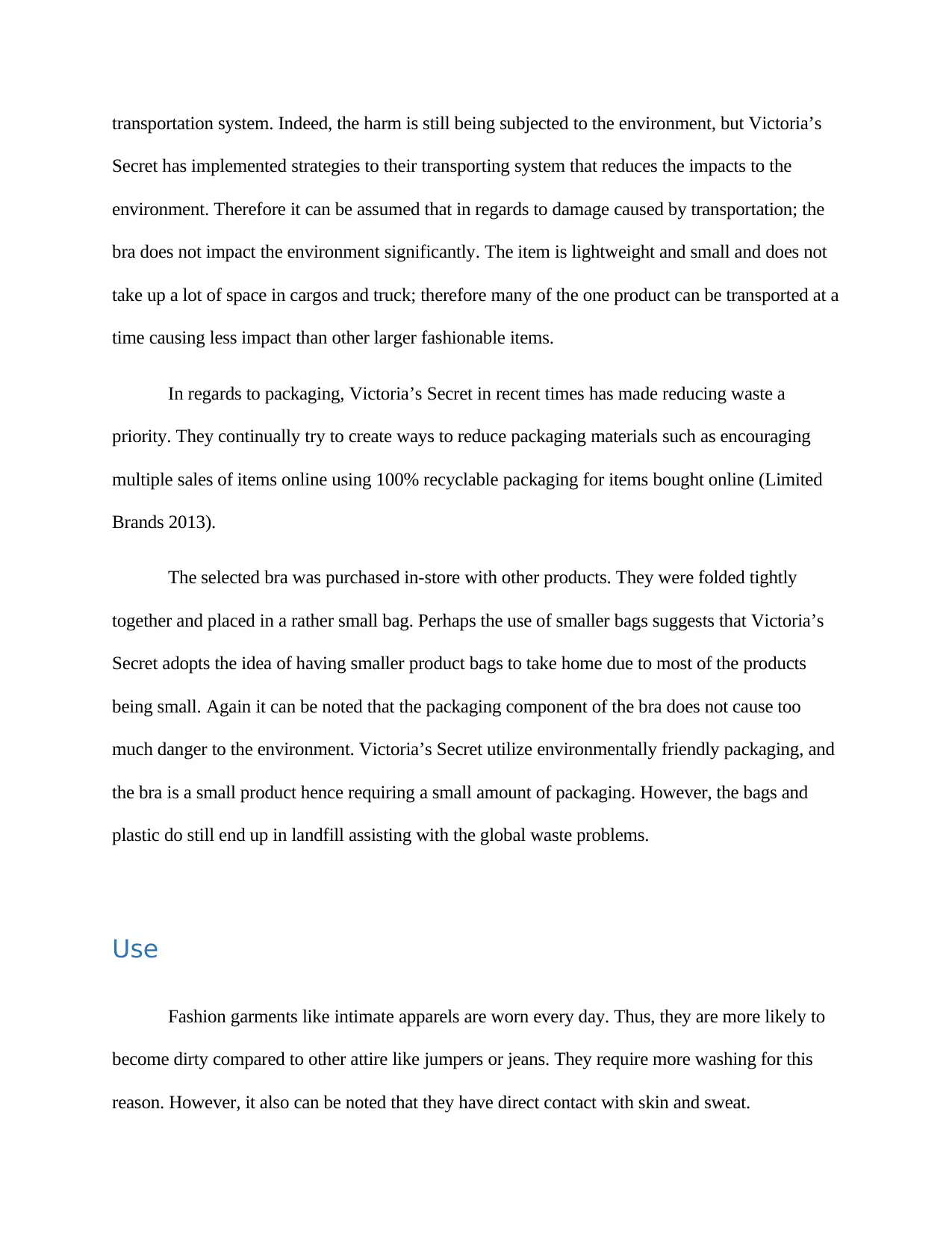
transportation system. Indeed, the harm is still being subjected to the environment, but Victoria’s
Secret has implemented strategies to their transporting system that reduces the impacts to the
environment. Therefore it can be assumed that in regards to damage caused by transportation; the
bra does not impact the environment significantly. The item is lightweight and small and does not
take up a lot of space in cargos and truck; therefore many of the one product can be transported at a
time causing less impact than other larger fashionable items.
In regards to packaging, Victoria’s Secret in recent times has made reducing waste a
priority. They continually try to create ways to reduce packaging materials such as encouraging
multiple sales of items online using 100% recyclable packaging for items bought online (Limited
Brands 2013).
The selected bra was purchased in-store with other products. They were folded tightly
together and placed in a rather small bag. Perhaps the use of smaller bags suggests that Victoria’s
Secret adopts the idea of having smaller product bags to take home due to most of the products
being small. Again it can be noted that the packaging component of the bra does not cause too
much danger to the environment. Victoria’s Secret utilize environmentally friendly packaging, and
the bra is a small product hence requiring a small amount of packaging. However, the bags and
plastic do still end up in landfill assisting with the global waste problems.
Use
Fashion garments like intimate apparels are worn every day. Thus, they are more likely to
become dirty compared to other attire like jumpers or jeans. They require more washing for this
reason. However, it also can be noted that they have direct contact with skin and sweat.
Secret has implemented strategies to their transporting system that reduces the impacts to the
environment. Therefore it can be assumed that in regards to damage caused by transportation; the
bra does not impact the environment significantly. The item is lightweight and small and does not
take up a lot of space in cargos and truck; therefore many of the one product can be transported at a
time causing less impact than other larger fashionable items.
In regards to packaging, Victoria’s Secret in recent times has made reducing waste a
priority. They continually try to create ways to reduce packaging materials such as encouraging
multiple sales of items online using 100% recyclable packaging for items bought online (Limited
Brands 2013).
The selected bra was purchased in-store with other products. They were folded tightly
together and placed in a rather small bag. Perhaps the use of smaller bags suggests that Victoria’s
Secret adopts the idea of having smaller product bags to take home due to most of the products
being small. Again it can be noted that the packaging component of the bra does not cause too
much danger to the environment. Victoria’s Secret utilize environmentally friendly packaging, and
the bra is a small product hence requiring a small amount of packaging. However, the bags and
plastic do still end up in landfill assisting with the global waste problems.
Use
Fashion garments like intimate apparels are worn every day. Thus, they are more likely to
become dirty compared to other attire like jumpers or jeans. They require more washing for this
reason. However, it also can be noted that they have direct contact with skin and sweat.
Secure Best Marks with AI Grader
Need help grading? Try our AI Grader for instant feedback on your assignments.
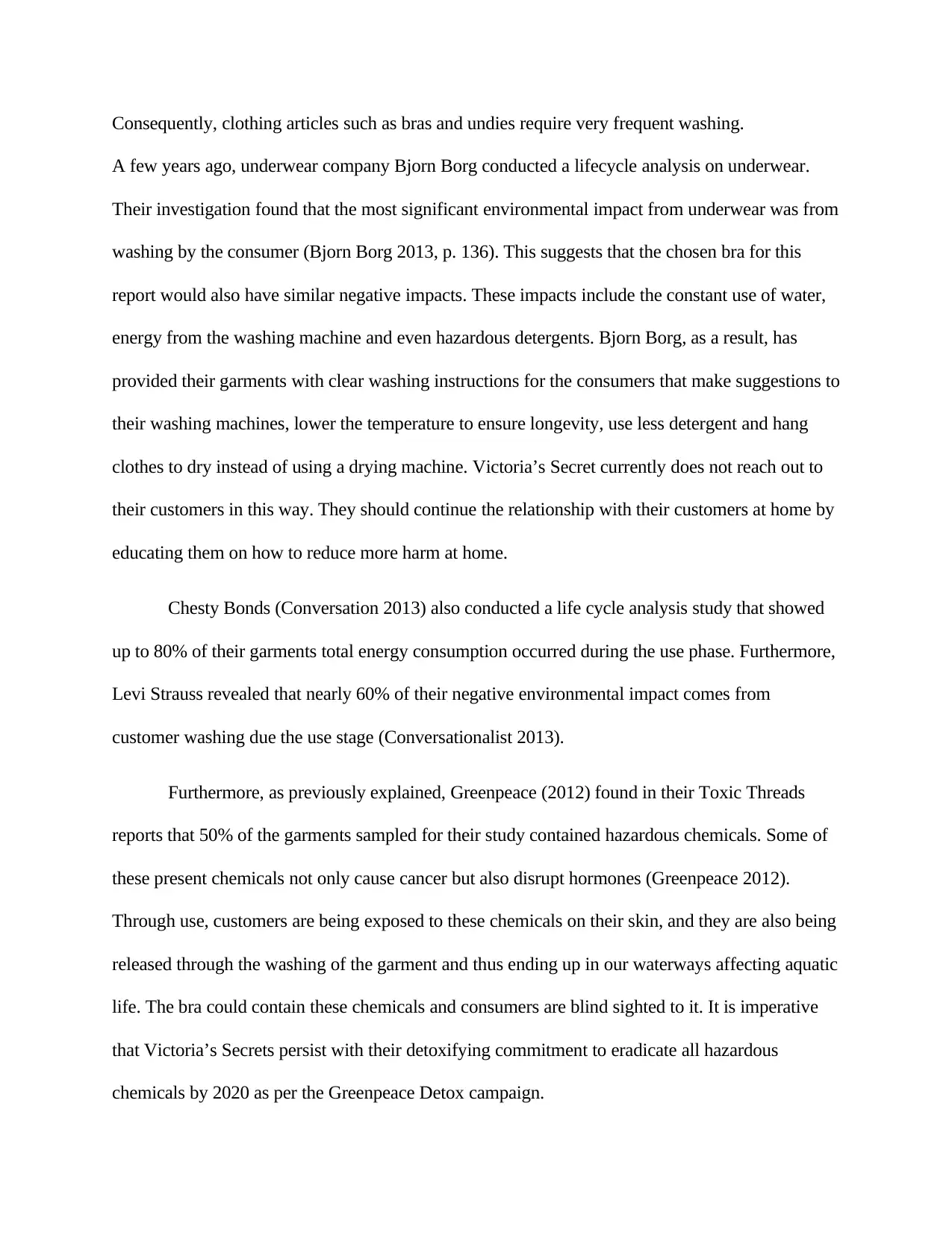
Consequently, clothing articles such as bras and undies require very frequent washing.
A few years ago, underwear company Bjorn Borg conducted a lifecycle analysis on underwear.
Their investigation found that the most significant environmental impact from underwear was from
washing by the consumer (Bjorn Borg 2013, p. 136). This suggests that the chosen bra for this
report would also have similar negative impacts. These impacts include the constant use of water,
energy from the washing machine and even hazardous detergents. Bjorn Borg, as a result, has
provided their garments with clear washing instructions for the consumers that make suggestions to
their washing machines, lower the temperature to ensure longevity, use less detergent and hang
clothes to dry instead of using a drying machine. Victoria’s Secret currently does not reach out to
their customers in this way. They should continue the relationship with their customers at home by
educating them on how to reduce more harm at home.
Chesty Bonds (Conversation 2013) also conducted a life cycle analysis study that showed
up to 80% of their garments total energy consumption occurred during the use phase. Furthermore,
Levi Strauss revealed that nearly 60% of their negative environmental impact comes from
customer washing due the use stage (Conversationalist 2013).
Furthermore, as previously explained, Greenpeace (2012) found in their Toxic Threads
reports that 50% of the garments sampled for their study contained hazardous chemicals. Some of
these present chemicals not only cause cancer but also disrupt hormones (Greenpeace 2012).
Through use, customers are being exposed to these chemicals on their skin, and they are also being
released through the washing of the garment and thus ending up in our waterways affecting aquatic
life. The bra could contain these chemicals and consumers are blind sighted to it. It is imperative
that Victoria’s Secrets persist with their detoxifying commitment to eradicate all hazardous
chemicals by 2020 as per the Greenpeace Detox campaign.
A few years ago, underwear company Bjorn Borg conducted a lifecycle analysis on underwear.
Their investigation found that the most significant environmental impact from underwear was from
washing by the consumer (Bjorn Borg 2013, p. 136). This suggests that the chosen bra for this
report would also have similar negative impacts. These impacts include the constant use of water,
energy from the washing machine and even hazardous detergents. Bjorn Borg, as a result, has
provided their garments with clear washing instructions for the consumers that make suggestions to
their washing machines, lower the temperature to ensure longevity, use less detergent and hang
clothes to dry instead of using a drying machine. Victoria’s Secret currently does not reach out to
their customers in this way. They should continue the relationship with their customers at home by
educating them on how to reduce more harm at home.
Chesty Bonds (Conversation 2013) also conducted a life cycle analysis study that showed
up to 80% of their garments total energy consumption occurred during the use phase. Furthermore,
Levi Strauss revealed that nearly 60% of their negative environmental impact comes from
customer washing due the use stage (Conversationalist 2013).
Furthermore, as previously explained, Greenpeace (2012) found in their Toxic Threads
reports that 50% of the garments sampled for their study contained hazardous chemicals. Some of
these present chemicals not only cause cancer but also disrupt hormones (Greenpeace 2012).
Through use, customers are being exposed to these chemicals on their skin, and they are also being
released through the washing of the garment and thus ending up in our waterways affecting aquatic
life. The bra could contain these chemicals and consumers are blind sighted to it. It is imperative
that Victoria’s Secrets persist with their detoxifying commitment to eradicate all hazardous
chemicals by 2020 as per the Greenpeace Detox campaign.
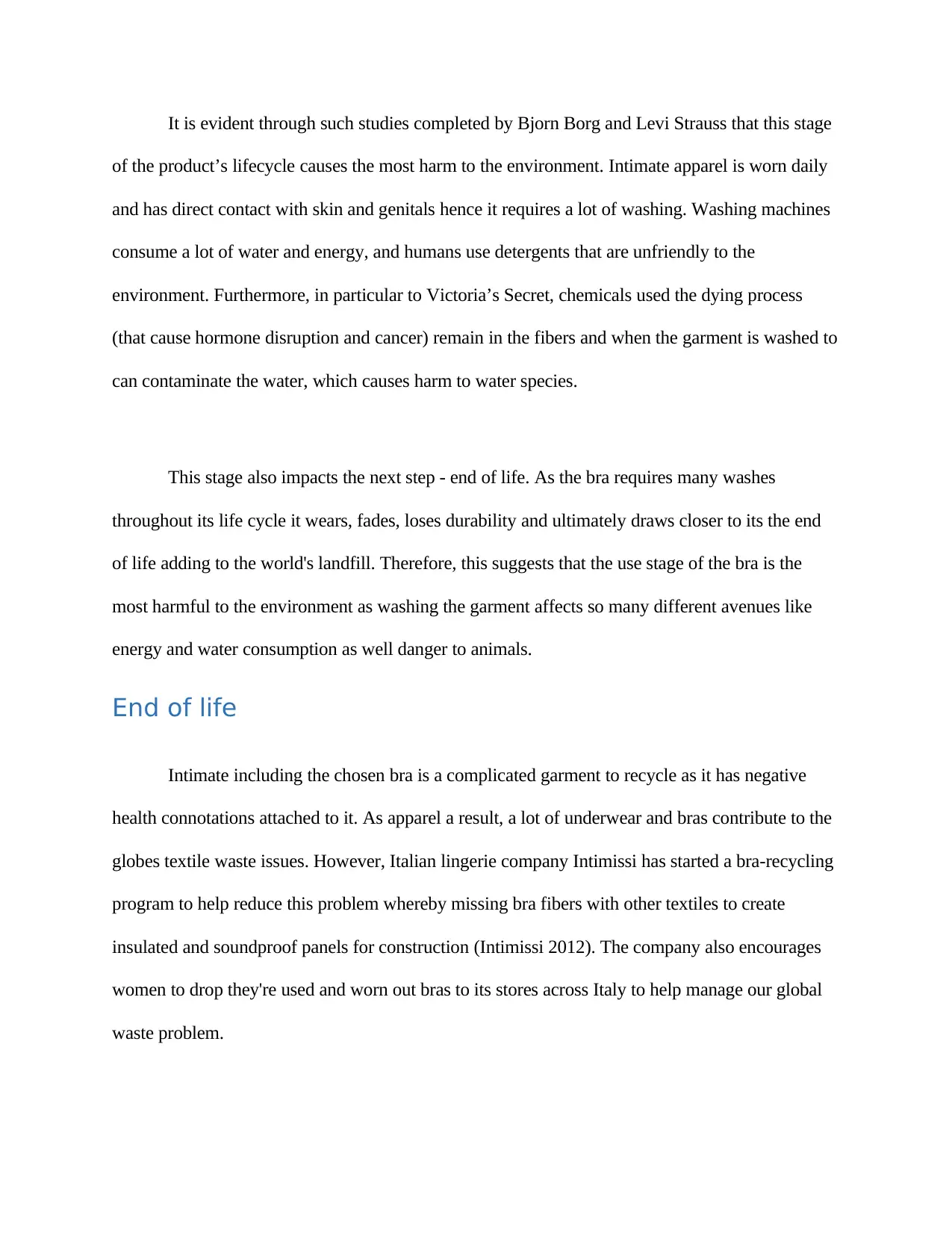
It is evident through such studies completed by Bjorn Borg and Levi Strauss that this stage
of the product’s lifecycle causes the most harm to the environment. Intimate apparel is worn daily
and has direct contact with skin and genitals hence it requires a lot of washing. Washing machines
consume a lot of water and energy, and humans use detergents that are unfriendly to the
environment. Furthermore, in particular to Victoria’s Secret, chemicals used the dying process
(that cause hormone disruption and cancer) remain in the fibers and when the garment is washed to
can contaminate the water, which causes harm to water species.
This stage also impacts the next step - end of life. As the bra requires many washes
throughout its life cycle it wears, fades, loses durability and ultimately draws closer to its the end
of life adding to the world's landfill. Therefore, this suggests that the use stage of the bra is the
most harmful to the environment as washing the garment affects so many different avenues like
energy and water consumption as well danger to animals.
End of life
Intimate including the chosen bra is a complicated garment to recycle as it has negative
health connotations attached to it. As apparel a result, a lot of underwear and bras contribute to the
globes textile waste issues. However, Italian lingerie company Intimissi has started a bra-recycling
program to help reduce this problem whereby missing bra fibers with other textiles to create
insulated and soundproof panels for construction (Intimissi 2012). The company also encourages
women to drop they're used and worn out bras to its stores across Italy to help manage our global
waste problem.
of the product’s lifecycle causes the most harm to the environment. Intimate apparel is worn daily
and has direct contact with skin and genitals hence it requires a lot of washing. Washing machines
consume a lot of water and energy, and humans use detergents that are unfriendly to the
environment. Furthermore, in particular to Victoria’s Secret, chemicals used the dying process
(that cause hormone disruption and cancer) remain in the fibers and when the garment is washed to
can contaminate the water, which causes harm to water species.
This stage also impacts the next step - end of life. As the bra requires many washes
throughout its life cycle it wears, fades, loses durability and ultimately draws closer to its the end
of life adding to the world's landfill. Therefore, this suggests that the use stage of the bra is the
most harmful to the environment as washing the garment affects so many different avenues like
energy and water consumption as well danger to animals.
End of life
Intimate including the chosen bra is a complicated garment to recycle as it has negative
health connotations attached to it. As apparel a result, a lot of underwear and bras contribute to the
globes textile waste issues. However, Italian lingerie company Intimissi has started a bra-recycling
program to help reduce this problem whereby missing bra fibers with other textiles to create
insulated and soundproof panels for construction (Intimissi 2012). The company also encourages
women to drop they're used and worn out bras to its stores across Italy to help manage our global
waste problem.
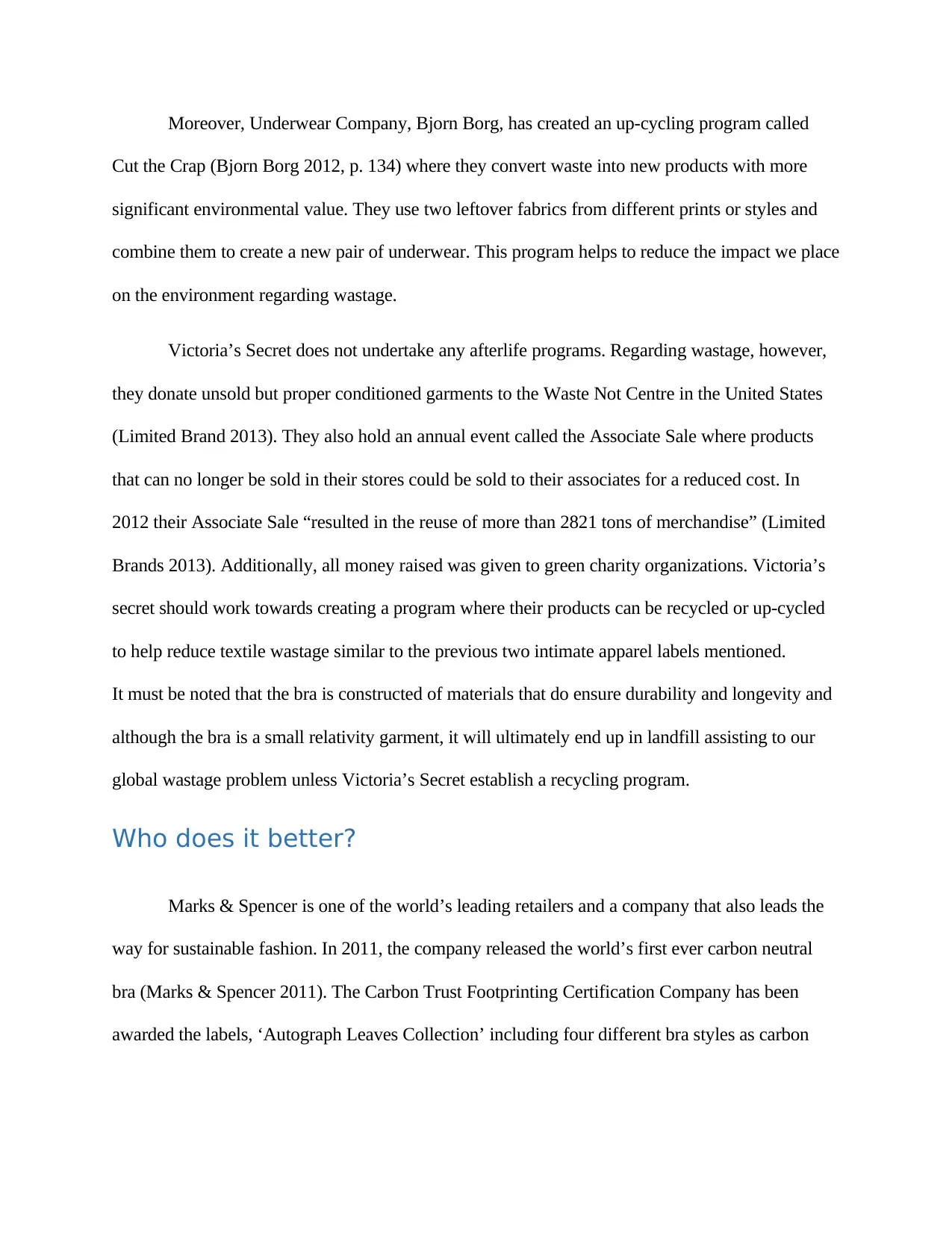
Moreover, Underwear Company, Bjorn Borg, has created an up-cycling program called
Cut the Crap (Bjorn Borg 2012, p. 134) where they convert waste into new products with more
significant environmental value. They use two leftover fabrics from different prints or styles and
combine them to create a new pair of underwear. This program helps to reduce the impact we place
on the environment regarding wastage.
Victoria’s Secret does not undertake any afterlife programs. Regarding wastage, however,
they donate unsold but proper conditioned garments to the Waste Not Centre in the United States
(Limited Brand 2013). They also hold an annual event called the Associate Sale where products
that can no longer be sold in their stores could be sold to their associates for a reduced cost. In
2012 their Associate Sale “resulted in the reuse of more than 2821 tons of merchandise” (Limited
Brands 2013). Additionally, all money raised was given to green charity organizations. Victoria’s
secret should work towards creating a program where their products can be recycled or up-cycled
to help reduce textile wastage similar to the previous two intimate apparel labels mentioned.
It must be noted that the bra is constructed of materials that do ensure durability and longevity and
although the bra is a small relativity garment, it will ultimately end up in landfill assisting to our
global wastage problem unless Victoria’s Secret establish a recycling program.
Who does it better?
Marks & Spencer is one of the world’s leading retailers and a company that also leads the
way for sustainable fashion. In 2011, the company released the world’s first ever carbon neutral
bra (Marks & Spencer 2011). The Carbon Trust Footprinting Certification Company has been
awarded the labels, ‘Autograph Leaves Collection’ including four different bra styles as carbon
Cut the Crap (Bjorn Borg 2012, p. 134) where they convert waste into new products with more
significant environmental value. They use two leftover fabrics from different prints or styles and
combine them to create a new pair of underwear. This program helps to reduce the impact we place
on the environment regarding wastage.
Victoria’s Secret does not undertake any afterlife programs. Regarding wastage, however,
they donate unsold but proper conditioned garments to the Waste Not Centre in the United States
(Limited Brand 2013). They also hold an annual event called the Associate Sale where products
that can no longer be sold in their stores could be sold to their associates for a reduced cost. In
2012 their Associate Sale “resulted in the reuse of more than 2821 tons of merchandise” (Limited
Brands 2013). Additionally, all money raised was given to green charity organizations. Victoria’s
secret should work towards creating a program where their products can be recycled or up-cycled
to help reduce textile wastage similar to the previous two intimate apparel labels mentioned.
It must be noted that the bra is constructed of materials that do ensure durability and longevity and
although the bra is a small relativity garment, it will ultimately end up in landfill assisting to our
global wastage problem unless Victoria’s Secret establish a recycling program.
Who does it better?
Marks & Spencer is one of the world’s leading retailers and a company that also leads the
way for sustainable fashion. In 2011, the company released the world’s first ever carbon neutral
bra (Marks & Spencer 2011). The Carbon Trust Footprinting Certification Company has been
awarded the labels, ‘Autograph Leaves Collection’ including four different bra styles as carbon
Paraphrase This Document
Need a fresh take? Get an instant paraphrase of this document with our AI Paraphraser
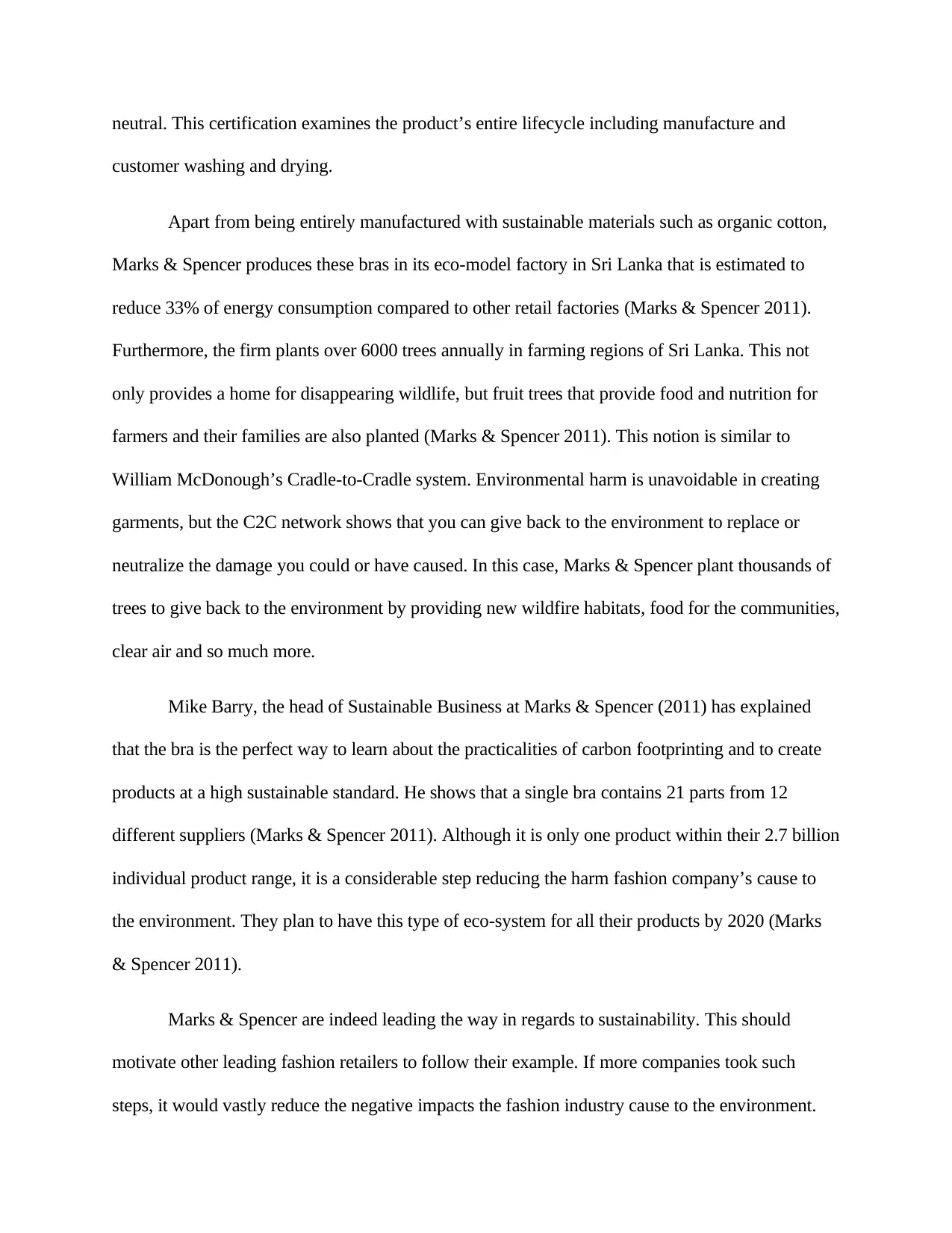
neutral. This certification examines the product’s entire lifecycle including manufacture and
customer washing and drying.
Apart from being entirely manufactured with sustainable materials such as organic cotton,
Marks & Spencer produces these bras in its eco-model factory in Sri Lanka that is estimated to
reduce 33% of energy consumption compared to other retail factories (Marks & Spencer 2011).
Furthermore, the firm plants over 6000 trees annually in farming regions of Sri Lanka. This not
only provides a home for disappearing wildlife, but fruit trees that provide food and nutrition for
farmers and their families are also planted (Marks & Spencer 2011). This notion is similar to
William McDonough’s Cradle-to-Cradle system. Environmental harm is unavoidable in creating
garments, but the C2C network shows that you can give back to the environment to replace or
neutralize the damage you could or have caused. In this case, Marks & Spencer plant thousands of
trees to give back to the environment by providing new wildfire habitats, food for the communities,
clear air and so much more.
Mike Barry, the head of Sustainable Business at Marks & Spencer (2011) has explained
that the bra is the perfect way to learn about the practicalities of carbon footprinting and to create
products at a high sustainable standard. He shows that a single bra contains 21 parts from 12
different suppliers (Marks & Spencer 2011). Although it is only one product within their 2.7 billion
individual product range, it is a considerable step reducing the harm fashion company’s cause to
the environment. They plan to have this type of eco-system for all their products by 2020 (Marks
& Spencer 2011).
Marks & Spencer are indeed leading the way in regards to sustainability. This should
motivate other leading fashion retailers to follow their example. If more companies took such
steps, it would vastly reduce the negative impacts the fashion industry cause to the environment.
customer washing and drying.
Apart from being entirely manufactured with sustainable materials such as organic cotton,
Marks & Spencer produces these bras in its eco-model factory in Sri Lanka that is estimated to
reduce 33% of energy consumption compared to other retail factories (Marks & Spencer 2011).
Furthermore, the firm plants over 6000 trees annually in farming regions of Sri Lanka. This not
only provides a home for disappearing wildlife, but fruit trees that provide food and nutrition for
farmers and their families are also planted (Marks & Spencer 2011). This notion is similar to
William McDonough’s Cradle-to-Cradle system. Environmental harm is unavoidable in creating
garments, but the C2C network shows that you can give back to the environment to replace or
neutralize the damage you could or have caused. In this case, Marks & Spencer plant thousands of
trees to give back to the environment by providing new wildfire habitats, food for the communities,
clear air and so much more.
Mike Barry, the head of Sustainable Business at Marks & Spencer (2011) has explained
that the bra is the perfect way to learn about the practicalities of carbon footprinting and to create
products at a high sustainable standard. He shows that a single bra contains 21 parts from 12
different suppliers (Marks & Spencer 2011). Although it is only one product within their 2.7 billion
individual product range, it is a considerable step reducing the harm fashion company’s cause to
the environment. They plan to have this type of eco-system for all their products by 2020 (Marks
& Spencer 2011).
Marks & Spencer are indeed leading the way in regards to sustainability. This should
motivate other leading fashion retailers to follow their example. If more companies took such
steps, it would vastly reduce the negative impacts the fashion industry cause to the environment.

Victoria’s Secret could also start with making one of their products carbon neutral and slowly grow
in line with Marks & Spencer
in line with Marks & Spencer
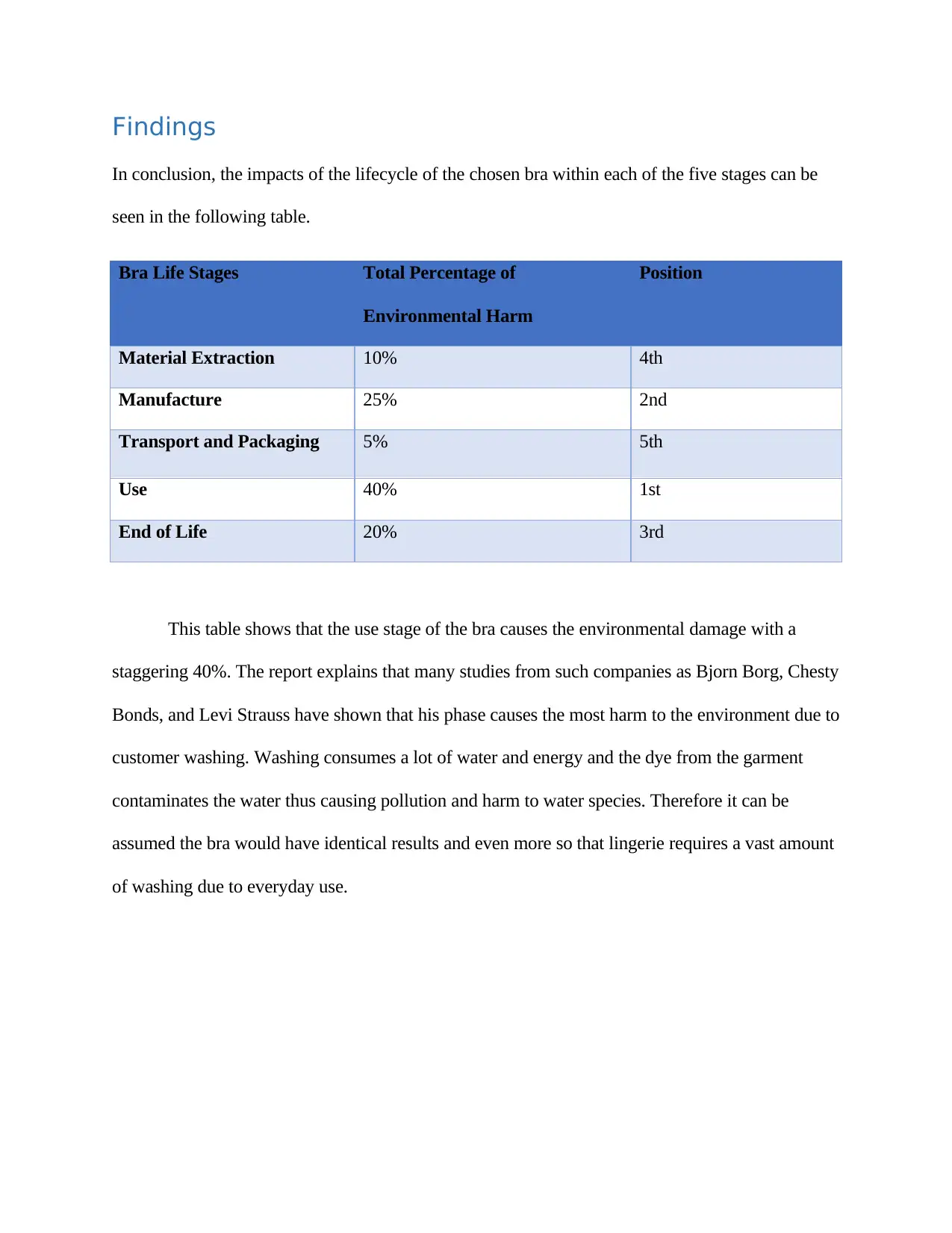
Findings
In conclusion, the impacts of the lifecycle of the chosen bra within each of the five stages can be
seen in the following table.
Bra Life Stages Total Percentage of
Environmental Harm
Position
Material Extraction 10% 4th
Manufacture 25% 2nd
Transport and Packaging 5% 5th
Use 40% 1st
End of Life 20% 3rd
This table shows that the use stage of the bra causes the environmental damage with a
staggering 40%. The report explains that many studies from such companies as Bjorn Borg, Chesty
Bonds, and Levi Strauss have shown that his phase causes the most harm to the environment due to
customer washing. Washing consumes a lot of water and energy and the dye from the garment
contaminates the water thus causing pollution and harm to water species. Therefore it can be
assumed the bra would have identical results and even more so that lingerie requires a vast amount
of washing due to everyday use.
In conclusion, the impacts of the lifecycle of the chosen bra within each of the five stages can be
seen in the following table.
Bra Life Stages Total Percentage of
Environmental Harm
Position
Material Extraction 10% 4th
Manufacture 25% 2nd
Transport and Packaging 5% 5th
Use 40% 1st
End of Life 20% 3rd
This table shows that the use stage of the bra causes the environmental damage with a
staggering 40%. The report explains that many studies from such companies as Bjorn Borg, Chesty
Bonds, and Levi Strauss have shown that his phase causes the most harm to the environment due to
customer washing. Washing consumes a lot of water and energy and the dye from the garment
contaminates the water thus causing pollution and harm to water species. Therefore it can be
assumed the bra would have identical results and even more so that lingerie requires a vast amount
of washing due to everyday use.
Secure Best Marks with AI Grader
Need help grading? Try our AI Grader for instant feedback on your assignments.
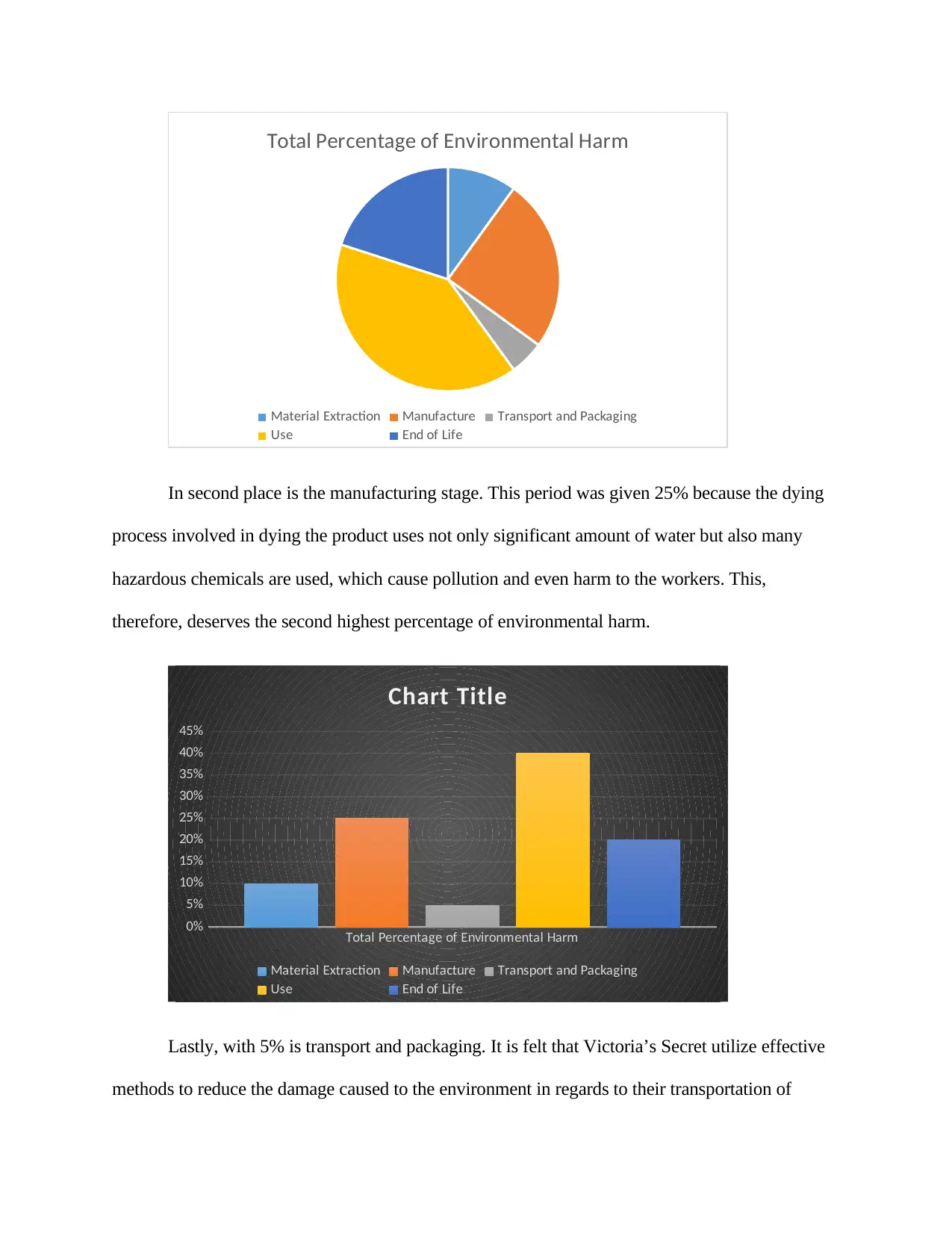
Total Percentage of Environmental Harm
Material Extraction Manufacture Transport and Packaging
Use End of Life
In second place is the manufacturing stage. This period was given 25% because the dying
process involved in dying the product uses not only significant amount of water but also many
hazardous chemicals are used, which cause pollution and even harm to the workers. This,
therefore, deserves the second highest percentage of environmental harm.
Total Percentage of Environmental Harm
0%
5%
10%
15%
20%
25%
30%
35%
40%
45%
Chart Title
Material Extraction Manufacture Transport and Packaging
Use End of Life
Lastly, with 5% is transport and packaging. It is felt that Victoria’s Secret utilize effective
methods to reduce the damage caused to the environment in regards to their transportation of
Material Extraction Manufacture Transport and Packaging
Use End of Life
In second place is the manufacturing stage. This period was given 25% because the dying
process involved in dying the product uses not only significant amount of water but also many
hazardous chemicals are used, which cause pollution and even harm to the workers. This,
therefore, deserves the second highest percentage of environmental harm.
Total Percentage of Environmental Harm
0%
5%
10%
15%
20%
25%
30%
35%
40%
45%
Chart Title
Material Extraction Manufacture Transport and Packaging
Use End of Life
Lastly, with 5% is transport and packaging. It is felt that Victoria’s Secret utilize effective
methods to reduce the damage caused to the environment in regards to their transportation of
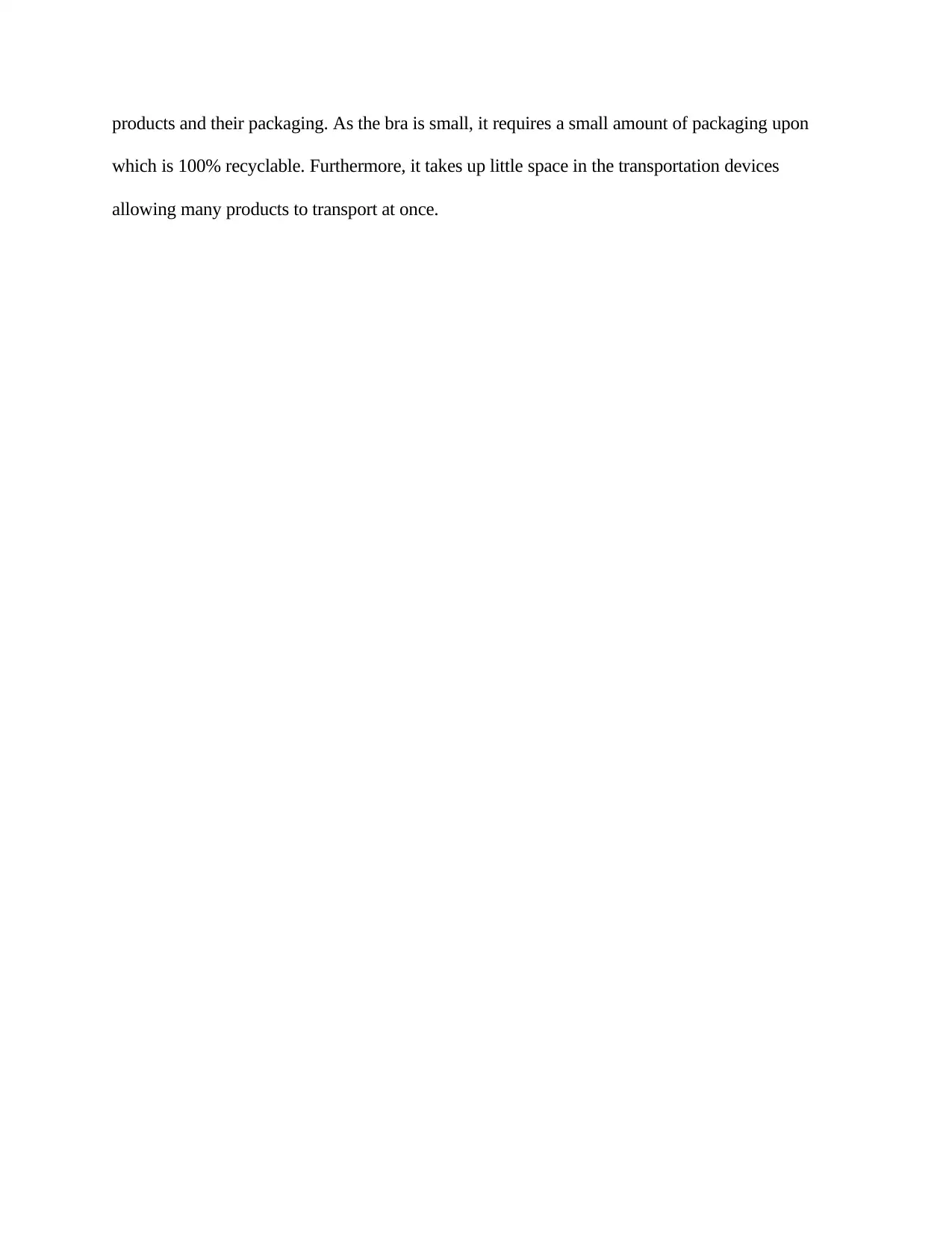
products and their packaging. As the bra is small, it requires a small amount of packaging upon
which is 100% recyclable. Furthermore, it takes up little space in the transportation devices
allowing many products to transport at once.
which is 100% recyclable. Furthermore, it takes up little space in the transportation devices
allowing many products to transport at once.
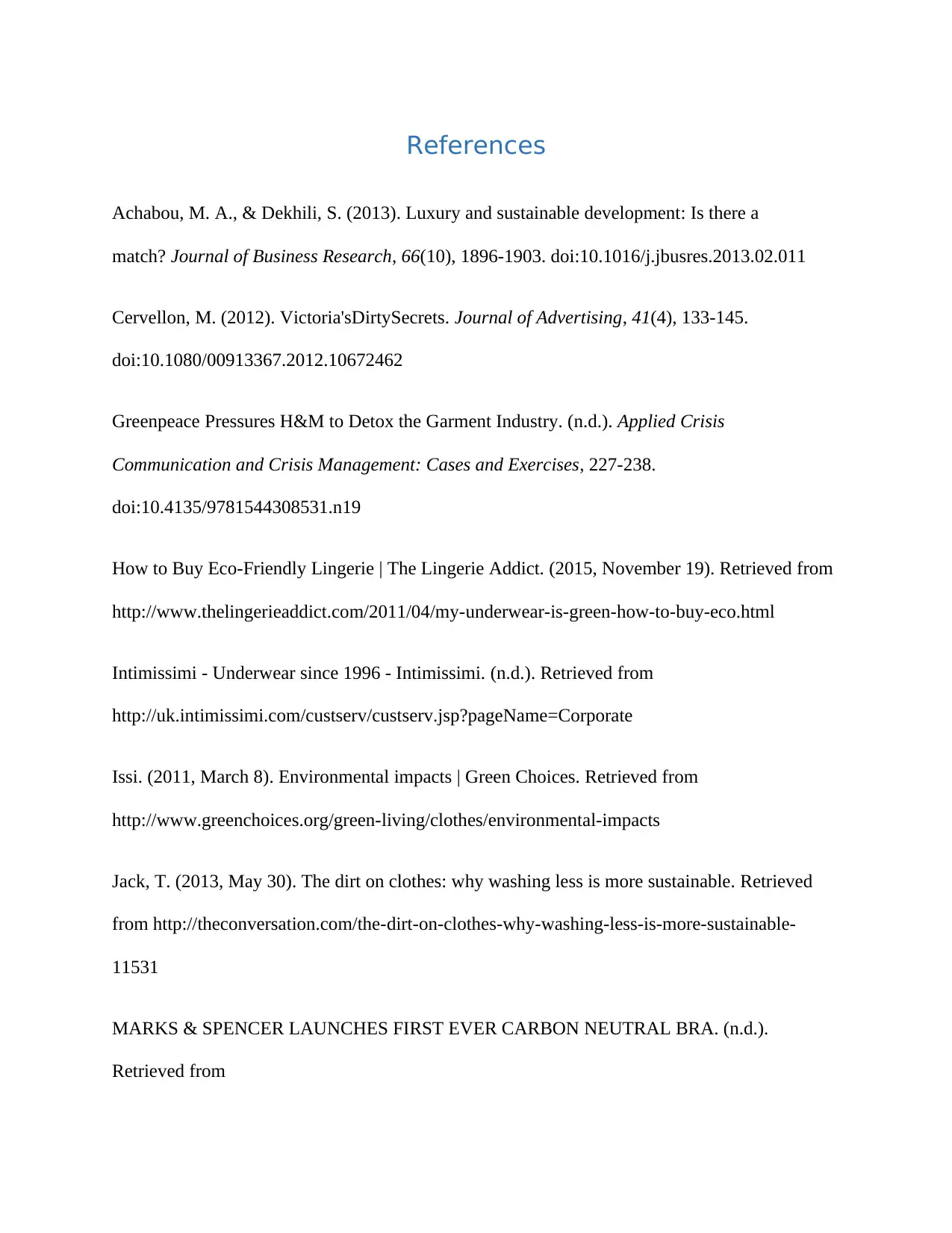
References
Achabou, M. A., & Dekhili, S. (2013). Luxury and sustainable development: Is there a
match? Journal of Business Research, 66(10), 1896-1903. doi:10.1016/j.jbusres.2013.02.011
Cervellon, M. (2012). Victoria'sDirtySecrets. Journal of Advertising, 41(4), 133-145.
doi:10.1080/00913367.2012.10672462
Greenpeace Pressures H&M to Detox the Garment Industry. (n.d.). Applied Crisis
Communication and Crisis Management: Cases and Exercises, 227-238.
doi:10.4135/9781544308531.n19
How to Buy Eco-Friendly Lingerie | The Lingerie Addict. (2015, November 19). Retrieved from
http://www.thelingerieaddict.com/2011/04/my-underwear-is-green-how-to-buy-eco.html
Intimissimi - Underwear since 1996 - Intimissimi. (n.d.). Retrieved from
http://uk.intimissimi.com/custserv/custserv.jsp?pageName=Corporate
Issi. (2011, March 8). Environmental impacts | Green Choices. Retrieved from
http://www.greenchoices.org/green-living/clothes/environmental-impacts
Jack, T. (2013, May 30). The dirt on clothes: why washing less is more sustainable. Retrieved
from http://theconversation.com/the-dirt-on-clothes-why-washing-less-is-more-sustainable-
11531
MARKS & SPENCER LAUNCHES FIRST EVER CARBON NEUTRAL BRA. (n.d.).
Retrieved from
Achabou, M. A., & Dekhili, S. (2013). Luxury and sustainable development: Is there a
match? Journal of Business Research, 66(10), 1896-1903. doi:10.1016/j.jbusres.2013.02.011
Cervellon, M. (2012). Victoria'sDirtySecrets. Journal of Advertising, 41(4), 133-145.
doi:10.1080/00913367.2012.10672462
Greenpeace Pressures H&M to Detox the Garment Industry. (n.d.). Applied Crisis
Communication and Crisis Management: Cases and Exercises, 227-238.
doi:10.4135/9781544308531.n19
How to Buy Eco-Friendly Lingerie | The Lingerie Addict. (2015, November 19). Retrieved from
http://www.thelingerieaddict.com/2011/04/my-underwear-is-green-how-to-buy-eco.html
Intimissimi - Underwear since 1996 - Intimissimi. (n.d.). Retrieved from
http://uk.intimissimi.com/custserv/custserv.jsp?pageName=Corporate
Issi. (2011, March 8). Environmental impacts | Green Choices. Retrieved from
http://www.greenchoices.org/green-living/clothes/environmental-impacts
Jack, T. (2013, May 30). The dirt on clothes: why washing less is more sustainable. Retrieved
from http://theconversation.com/the-dirt-on-clothes-why-washing-less-is-more-sustainable-
11531
MARKS & SPENCER LAUNCHES FIRST EVER CARBON NEUTRAL BRA. (n.d.).
Retrieved from
Paraphrase This Document
Need a fresh take? Get an instant paraphrase of this document with our AI Paraphraser
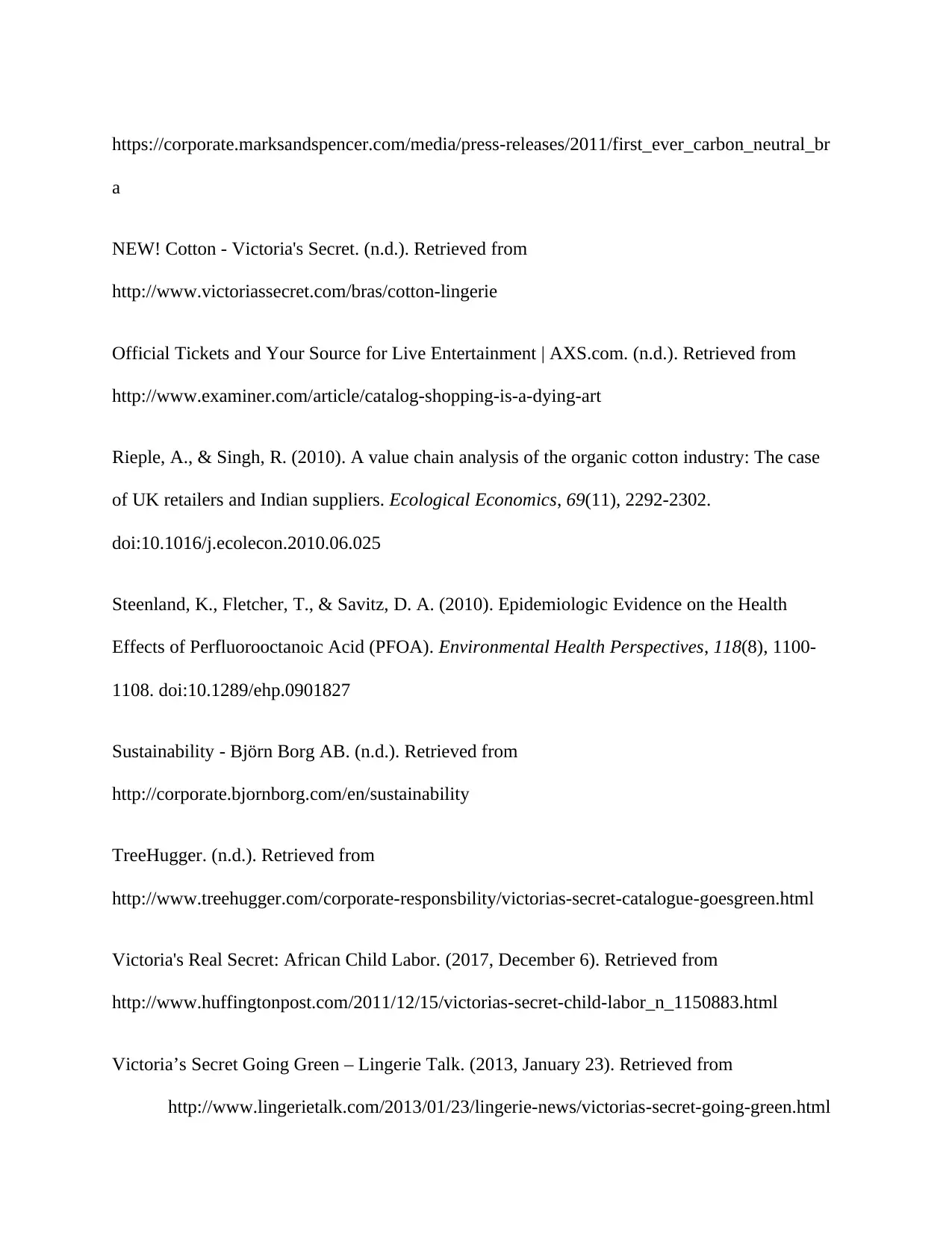
https://corporate.marksandspencer.com/media/press-releases/2011/first_ever_carbon_neutral_br
a
NEW! Cotton - Victoria's Secret. (n.d.). Retrieved from
http://www.victoriassecret.com/bras/cotton-lingerie
Official Tickets and Your Source for Live Entertainment | AXS.com. (n.d.). Retrieved from
http://www.examiner.com/article/catalog-shopping-is-a-dying-art
Rieple, A., & Singh, R. (2010). A value chain analysis of the organic cotton industry: The case
of UK retailers and Indian suppliers. Ecological Economics, 69(11), 2292-2302.
doi:10.1016/j.ecolecon.2010.06.025
Steenland, K., Fletcher, T., & Savitz, D. A. (2010). Epidemiologic Evidence on the Health
Effects of Perfluorooctanoic Acid (PFOA). Environmental Health Perspectives, 118(8), 1100-
1108. doi:10.1289/ehp.0901827
Sustainability - Björn Borg AB. (n.d.). Retrieved from
http://corporate.bjornborg.com/en/sustainability
TreeHugger. (n.d.). Retrieved from
http://www.treehugger.com/corporate-responsbility/victorias-secret-catalogue-goesgreen.html
Victoria's Real Secret: African Child Labor. (2017, December 6). Retrieved from
http://www.huffingtonpost.com/2011/12/15/victorias-secret-child-labor_n_1150883.html
Victoria’s Secret Going Green – Lingerie Talk. (2013, January 23). Retrieved from
http://www.lingerietalk.com/2013/01/23/lingerie-news/victorias-secret-going-green.html
a
NEW! Cotton - Victoria's Secret. (n.d.). Retrieved from
http://www.victoriassecret.com/bras/cotton-lingerie
Official Tickets and Your Source for Live Entertainment | AXS.com. (n.d.). Retrieved from
http://www.examiner.com/article/catalog-shopping-is-a-dying-art
Rieple, A., & Singh, R. (2010). A value chain analysis of the organic cotton industry: The case
of UK retailers and Indian suppliers. Ecological Economics, 69(11), 2292-2302.
doi:10.1016/j.ecolecon.2010.06.025
Steenland, K., Fletcher, T., & Savitz, D. A. (2010). Epidemiologic Evidence on the Health
Effects of Perfluorooctanoic Acid (PFOA). Environmental Health Perspectives, 118(8), 1100-
1108. doi:10.1289/ehp.0901827
Sustainability - Björn Borg AB. (n.d.). Retrieved from
http://corporate.bjornborg.com/en/sustainability
TreeHugger. (n.d.). Retrieved from
http://www.treehugger.com/corporate-responsbility/victorias-secret-catalogue-goesgreen.html
Victoria's Real Secret: African Child Labor. (2017, December 6). Retrieved from
http://www.huffingtonpost.com/2011/12/15/victorias-secret-child-labor_n_1150883.html
Victoria’s Secret Going Green – Lingerie Talk. (2013, January 23). Retrieved from
http://www.lingerietalk.com/2013/01/23/lingerie-news/victorias-secret-going-green.html

What should be the preferred cotton fabrics of large fashion companies? (2016, December 28).
Retrieved from http://buddhajeans.com/2012/07/20/what-kind-of-fabrics-is-the-most-
environmental-friendly/
Retrieved from http://buddhajeans.com/2012/07/20/what-kind-of-fabrics-is-the-most-
environmental-friendly/
1 out of 21
Your All-in-One AI-Powered Toolkit for Academic Success.
+13062052269
info@desklib.com
Available 24*7 on WhatsApp / Email
![[object Object]](/_next/static/media/star-bottom.7253800d.svg)
Unlock your academic potential
© 2024 | Zucol Services PVT LTD | All rights reserved.
